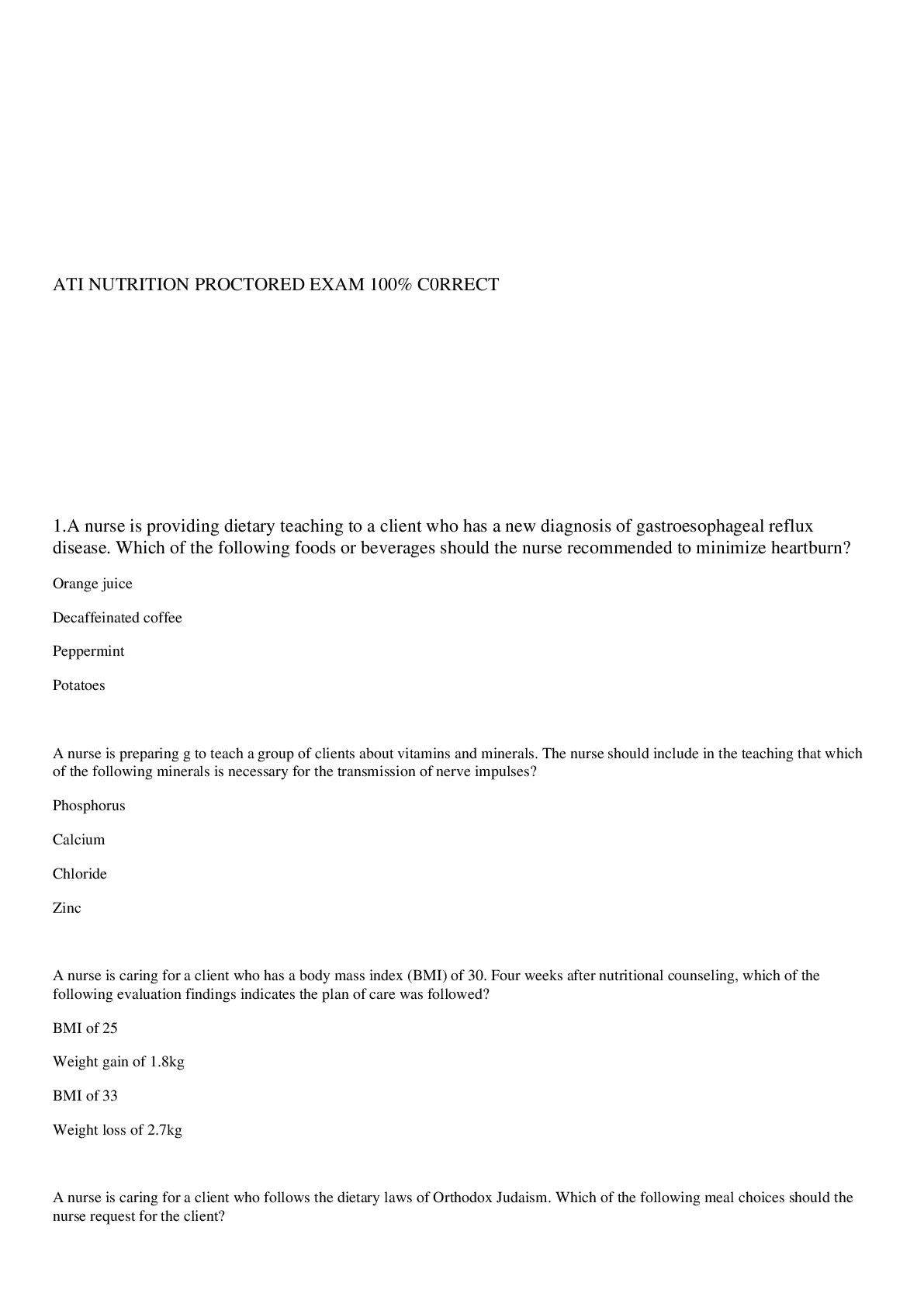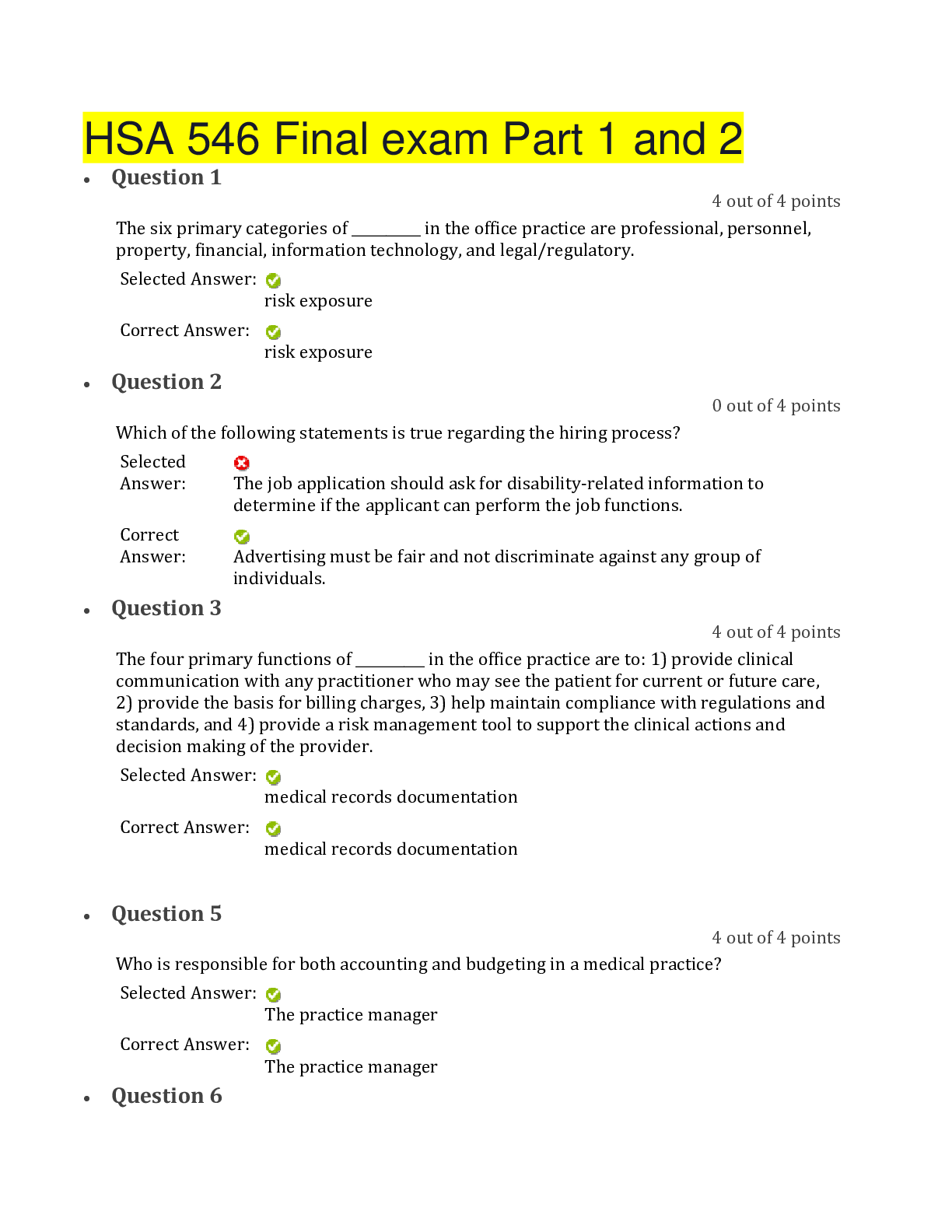*NURSING > EXAM > NSG6435 test bank ( LATEST) questions and answers - South University (A grade) (All)
NSG6435 test bank ( LATEST) questions and answers - South University (A grade)
Document Content and Description Below
NSG6435 test bank ( LATEST) questions and answers - South University (A grade) Burns: Pediatric Primary Care, 6th Edition Chapter 25: Atopic, Rheumatic, and Immunodeficiency Disorders Test Bank... Multiple Choice 1. 1. The parent of a school-age child reports that the child usually has allergic rhinitis symptoms beginning each fall and that non-sedating antihistamines are only marginally effective, especially for nasal obstruction symptoms. What will the primary care pediatric nurse practitioner do? a. a. Order an intranasal corticosteroid to begin 1 to 2 weeks prior to pollen season. b. b. Prescribe a decongestant medication as adjunct therapy during pollen season. c. c. Recommend adding diphenhydramine to the child’s regimen for additional relief. d. d. Suggest using an over-the-counter intranasal decongestant. ANS: A Intranasal corticosteroids are a key component in long-term therapy to manage symptoms associated with AR. These should be begun 1 to 2 weeks prior to the beginning of pollen season. Decongestants are not recommended for long-term use because of side effects. Diphenhydramine causes daytime drowsiness. 1. 2. The primary care pediatric nurse practitioner sees a child for follow-up care after hospitalization for ARF. The child has polyarthritis but no cardiac involvement. What will the nurse practitioner teach the family about ongoing care for this child? a. a. Aspirin is given for 2 weeks and then tapered to discontinue the medication. b. b. Prophylactic amoxicillin will need to be given for 5 years. c. c. Steroids will be necessary to prevent development of heart disease. d. d. The child will need complete bedrest until all symptoms subside. ANS: A ASA is given for arthritis for 2 weeks and then will be tapered. Children with ARF will need penicillin prophylaxis, not amoxicillin. Steroids are sometimes used for symptomatic relief but do not prevent chronic heart disease. Bed rest is indicated only when cardiac symptoms occur. 1. 3. A school-age child with asthma is seen for a well child checkup and, in spite of “feeling fine,” has pronounced expiratory wheezes, decreased breath sounds, and an FEV1 less than 70% of personal best. The primary care pediatric nurse practitioner learns that the child’s parent administers the daily medium-dose ICS but that the child is responsible for using the SABA. A treatment of 4 puffs of a SABA in clinic results in marked improvement in the child’s status. What will the nurse practitioner do? a. a. Have the parent administer all of the child’s medications. b. b. Increase the ICS medication to a high-dose preparation. c. c. Reinforce teaching about the importance of using the SABA. d. d. Teach the child and parent how to use home PEF monitoring. ANS: D Home PEF monitoring is useful for children to identify when symptoms are worsening. This child does not appear to notice the presence of airway tightness or wheezing and so might benefit from PEF monitoring to know when to use the SABA. School-age children should be learning how to manage their chronic disease, so having the parent administer all medications is not the best choice, especially since use of the SABA is still dependent on the child’s report of symptoms. Since the child responded well to administration of the SABA, increasing the dose of ICS should not be done unless better management is not effective. Reinforcing the teaching is part of the plan but, unless the child is aware of symptoms, may not occur. 1. 4. A child has a fever and arthralgia. The primary care pediatric nurse practitioner learns that the child had a sore throat 3 weeks prior and auscultates a murmur in the clinic. Which test will the nurse practitioner order? a. a. Anti-DNase B test b. b. ASO titer c. c. Rapid strep test d. d. Throat culture ANS: B This child has symptoms and a history consistent with ARF. The ASO titer peaks in 3 to 6 weeks and will confirm a recent strep infection. The anti-DNase B test will also confirm a recent strep infection, but this doesn’t peak until 6 to 8 weeks after the initial infection. A rapid strep test and throat culture do not differentiate the carrier state from a true infection. 1. 5. The primary care pediatric nurse practitioner is prescribing ibuprofen for a 25 kg child with JIA who has oligoarthitis. If the child will take 4 doses per day, what is the maximum amount the child will receive per dose? a. a. 200 mg b. b. 250 mg c. c. 400 mg d. d. 450 mg ANS: B The maximum dose is 40 mg/kg/day divided into 3 to 4 doses. 25 kg × 40 mg = 1000/4 = 250 mg. 1. 6. A school-age child who uses a SABA and an inhaled corticosteroid medication is seen in the clinic for an acute asthma exacerbation. After 4 puffs of an inhaled short-acting B2-agonist (SABA) every 20 minutes for three treatments, spirometry testing shows an FEV1 of 60% of the child’s personal best. What will the primary care pediatric nurse practitioner do next? a. a. Administer an oral corticosteroid and repeat the three treatments of the inhaled SABA. b. b. Admit the child to the hospital for every 2 hour inhaled SABA and intravenous steroids. c. c. Give the child 2 mg/kg of an oral corticosteroid and have the child taken to the emergency department. d. d. Order an oral corticosteroid, continue the SABA every 3 to 4 hours, and follow closely. ANS: D Children with an incomplete response (FEV1 between 40% and 69% of personal best) should be given oral steroids and instructed to continue the SABA every 3 to 4 hours with close follow-up. Hospitalization is not necessary unless severe distress occurs. An FEV1 less than 40% after treatment indicates a need to be seen in the ED. 1. 7. An adolescent who has asthma and severe perennial allergies has poor asthma control in spite of appropriate use of a SABA and a daily high-dose inhaled corticosteroid. What will the primary care pediatric nurse practitioner do next to manage this child’s asthma? a. a. Consider daily oral corticosteroid administration. b. b. Order an anticholinergic medication in conjunction with the current regimen. c. c. Prescribe a LABA/inhaled corticosteroid combination medication. d. d. Refer to a pulmonologist for omalizumab therapy. ANS: D Children older than 12 years who have moderate to severe allergy-related asthma and who react to perennial allergens may benefit from omalizumab as a second-line treatment when symptoms are not controlled by ICSs. The PNP should refer children to a pulmonologist for such treatment. Daily oral corticosteroid medications are not recommended because of the adverse effects caused by prolonged use of this route. Anticholinergic medications are generally used for acute exacerbations during in-patient stays or in the ED. A LABA/ICS combination will not produce different results. 1. 8. A 4-month-old infant has a history of reddened, dry, itchy skin. The primary care pediatric nurse practitioner notes fine papules on the extensor aspect of the infant’s arms, anterior thighs, and lateral aspects of the cheeks. What is the initial treatment? a. a. Moisturizers b. b. Oral antihistamines c. c. Topical corticosteroids d. d. Wet wrap therapy ANS: A Moisturization is the first-line therapy to interrupt the itch-scratch-itch cycle. Oral antihistamines are used mostly to allow sleep during nighttime pruritus. Topical corticosteroids are used if moisturization is not effective. Wet wrap therapy is used to treat flares with recalcitrant disease. 1. 9. An 8-year-old child is diagnosed with systemic lupus erythematosus (SLE), and the child’s parent asks if there is a cure. What will the primary care pediatric nurse practitioner tell the parent? a. a. Complete remission occurs in some children at the age of puberty. b. b. Periods of remission may occur but there is no permanent cure. c. c. SLE can be cured with effective medication and treatment. d. d. The disease is always progressive with no cure and no remissions. ANS: B Periods of remission do occur in some children with SLE for unknown reasons, but there is no permanent remission or cure. For some children with Juvenile Idiopathic Arthritis (JIA), complete remission occurs at puberty. 1. 10. The primary care pediatric nurse practitioner is examining a school-age child who has had several hospitalizations for bronchitis and wheezing. The parent reports that the child has several coughing episodes associated with chest tightness each week and gets relief with an albuterol metered-dose inhaler. What will the nurse practitioner order? a. a. Allergy testing b. b. Chest radiography c. c. Spirometry testing d. d. Sweat chloride test ANS: C Spirometry testing is the gold standard for diagnosing asthma and is then used on a regular basis to monitor, evaluate, and manage asthma. Allergy testing should be considered but is not diagnostic of asthma. Chest radiography should not be routine. A sweat chloride test is used based on history. 1. 11. The primary care pediatric nurse practitioner examines a child who has had stiffness and warmth in the right knee and left ankle for 7 or 8 months but no back pain. The nurse practitioner will refer the child to a rheumatology specialist to evaluate for a. a. enthesitis-related JIA. b. b. oligoarticular JIA. c. c. polyarticular JIA. d. d. systemic JIA. ANS: B Oligoarticular JIA is characterized by mild, painless asymmetric joint involvement without systemic symptoms. Enthesitis-related JIA involves arthritis of the lower limbs, especially the hips, intertarsal joints, and sacroiliac joints, with swelling, tenderness, and warmth. Polyarticular JIA involves 5 or more joints. Systemic JIA presents with systemic symptoms, such as fever. 1. 12. A child who has been diagnosed with asthma for several years has been using a short-acting B2-agonist (SABA) to control symptoms. The primary care pediatric nurse practitioner learns that the child has recently begun using the SABA two or three times each week to treat wheezing and shortness of breath. The child currently has clear breath sounds and an FEV1 of 75% of personal best. What will the nurse practitioner do next? a. a. Add a daily inhaled corticosteroid. b. b. Administer 3 SABA treatments. c. c. Continue the current treatment. d. d. Order an oral corticosteroid. ANS: A The child is showing a need to step up treatment based on the frequency of symptoms, greater than twice each week. The PNP should order an inhaled corticosteroid maintenance medication to control symptoms and reduce the need for a SABA. The child is not having an acute exacerbation, so does not need 3 SABA treatments. Oral corticosteroids are given for moderate obstruction, <70%. 1. 13. The primary care pediatric nurse practitioner is evaluating an 11-month-old infant who has had three viral respiratory illnesses causing bronchiolitis. The child’s parents both have seasonal allergies and ask whether the infant may have asthma. What will the nurse practitioner tell the parents? a. a. “Although it is likely, based on family history, it is too soon to tell.” b. b. “There is little reason to suspect that your infant has asthma.” c. c. “With your infant’s history of bronchiolitis, asthma is very likely.” d. d. “Your infant has definitive symptoms consistent with a diagnosis of asthma.” ANS: A A genetic predisposition for the development of an IgE-mediated response to aeroallergens is the strongest identifiable predisposing risk factor for asthma, but asthma is rarely diagnosed before age 12 months due to the high rate of viral-induced bronchiolitis. The PNP should be cautious about diagnosing asthma until wheezing without an association to viral illnesses occurs. This infant has clear risk factors for asthma; however, bronchiolitis is not a known risk factor. 1. 14. An 8-year-old boy has a recent history of an upper respiratory infection and comes to the clinic with a maculopapular rash on his lower extremities and swelling and tenderness in both ankles. The pediatric nurse practitioner performs a UA, which shows proteinuria and hematuria and diagnoses HSP. What ongoing evaluation will the nurse practitioner perform during the course of this disease? a. a. ANA titers b. b. Blood pressure measurement c. c. Chest radiographs d. d. Liver function studies ANS: B Hypertension is a serious risk of HSP, so repeated BP measurement is indicated. ANA titers are not measured with HSP. Chest radiographs are performed only if indicated. LFTs are not indicated; the predominant risk is to the kidneys. 1. 15. A 12-year-old child is brought to the clinic with joint pain, a 3-week history of low-grade fever, and a facial rash. The primary care pediatric nurse practitioner palpates an enlarged liver 2 cm below the subcostal margin along with diffuse lymphadenopathy. An ANA test is positive. Which test may be ordered to confirm a diagnosis of SLE? a. a. Anti-double-strand DNA antibodies b. b. Anti-La antibodies c. c. Anti-Ro antibodies d. d. Anti-Sm antibodies ANS: A Anti-double-strand DNA antibodies are present in most people with SLE and are generally exclusively seen in cases of SLE and not other diseases. Anti-SM antibodies are diagnostic of SLE but are only seen in 30% of patients with SLE. 1. 16. A 10-year-old child has a 1-week history of fever of 104°C that is unresponsive to antipyretics. The primary care pediatric nurse practitioner examines the child and notes bilateral conjunctival injection and a polymorphous exanthema, with no other symptoms. Lab tests show elevated ESR, CRP, and platelets. Cultures are all negative. What will the nurse practitioner do? a. a. Begin treatment with intravenous methyl prednisone. b. b. Consider IVIG therapy if symptoms persist one more week. c. c. Order a baseline echocardiogram today and another in 2 weeks. d. d. Reassure the child’s parents that this is a self-limiting disorder. ANS: C An echocardiogram should be obtained as soon as the diagnosis of Kawasaki disease (KD) is established, as a baseline study, with subsequent studies in 2 weeks and in 6 to 8 weeks. This child has fever and only two other symptoms, which may be consistent with atypical KD. Atypical KD is more common in very young children and in children over 9 years of age, and coronary artery involvement is found more frequently in children with atypical KD. Methyl prednisone is given for children with IVIG-resistant disease. IVIG should be begun ideally in the first 10 days of the illness. Although KD is a self-limiting disorder, the risk of coronary artery involvement is high, so this must be evaluated and treated. 1. 17. The primary care pediatric nurse practitioner is reviewing the rheumatology plan of care for a child who is diagnosed with SLE. Besides reinforcing information about prescribed medications, what will the nurse practitioner teach the family to help minimize flaring of episodes? a. a. Have the child rest between activities. b. b. Obtain regular ophthalmology exams. c. c. Participate in low-impact exercises. d. d. Use UVA and UVB sunscreen daily. ANS: D Sunlight is a known trigger of SLE so patients should be advised to use a UVA and UVB sunscreen both indoors and out. Resting between activities is recommended for children with JIA. Children should participate in low-impact activities, but this does not reduce the number of flares. Ophthalmology exams are recommended for children with JIA. - - - - - - - - - - - - 117. A 3-year-old child whose immunizations are up-to-date has been exposed to measles because of a localized outbreak among unvaccinated children. The parent reports that contact with infected children occurred within the last 2 days at a birthday party. What is the best course of action? a. Administer the MMR vaccine to help prevent disease. b. Give antiviral medications at the first sign of symptoms. c. Give the child a dose of immune globulin to mitigate the response. d. Reassure the parent that most exposed children will not get measles. ANS: A The measles vaccine can be given to those exposed if given within 72 hours of exposure. IG may be given in those without prior measles vaccine. Antiviral medications are not effective. Nine of 10 children who are unimmunized or under-immunized will contract the disease if exposed. 118. An 18-month-old child who developed upper respiratory symptoms 1 day prior is brought to the clinic with a high fever, chills, muscle pains, and a dry, hacking cough. A rapid influenza test is negative and a viral culture is pending. What will the primary care pediatric nurse practitioner do? a. Consider therapy with rimantadine. b. Hospitalize for supportive treatment. c. Prescribe oseltamivir and follow closely d. Wait for cultures to determine treatment. ANS: C A negative rapid viral culture should not be the determining factor when deciding on a clinical course of treatment when influenza is suspected. Children under age 2 years should be treated with antiviral medications. Rimantadine is not recommended unless susceptibility is reliable; cultures will not be confirmed for several days. It is not necessary to hospitalize unless the child has signs of respiratory distress or cardiac involvement. Antivirals should be initiated within 72 hours of onset of symptoms. 119. When reviewing a white blood cell (WBC) count, the primary care pediatric nurse practitioner suspects a viral infection when which WBC element is elevated? a. Bands b. Leukocytes c. Lymphocytes d. Neutrophils ANS: C Lymphocytes are usually elevated during viral infections. Bands and neutrophils are generally elevated with bacterial infections. Leukocytes comprise all WBCs and are usually, although not always, elevated during bacterial infections. 120. A 5-year-old child who received VariZIG after exposure to varicella while immunocompromised during chemotherapy is in the clinic 5 months after stopping chemotherapy for kindergarten vaccines. What will the primary care pediatric nurse practitioner order for this child? a. MMR and Tdap b. MMR, Varivax, Tdap c. Tdap only d. Varivax and Tdap ANS: B This child is eligible for all three vaccines. Varivax should be given 5 months after VariZIG, unless varicella disease occurred despite VariZIG administration. 121. A 7-year-old child whose immunizations are up-to-date has a fever, headache, stiff neck, and photophobia. What course of treatment is indicated? a. Empiric treatment with oral antibiotics or intramuscular ceftriaxone b. Hospitalization for diagnosis and treatment with antibiotics c. Immediate vaccination with meningococcal vaccine d. Outpatient lab work, including a CBC and blood and CSF cultures ANS: B Any child suspected of having meningococcal meningitis should be hospitalized immediately with IV antibiotics started pending cultures. Empiric treatment is not indicated. Vaccination is not helpful once the disease has started. Outpatient lab [Show More]
Last updated: 1 year ago
Preview 1 out of 78 pages
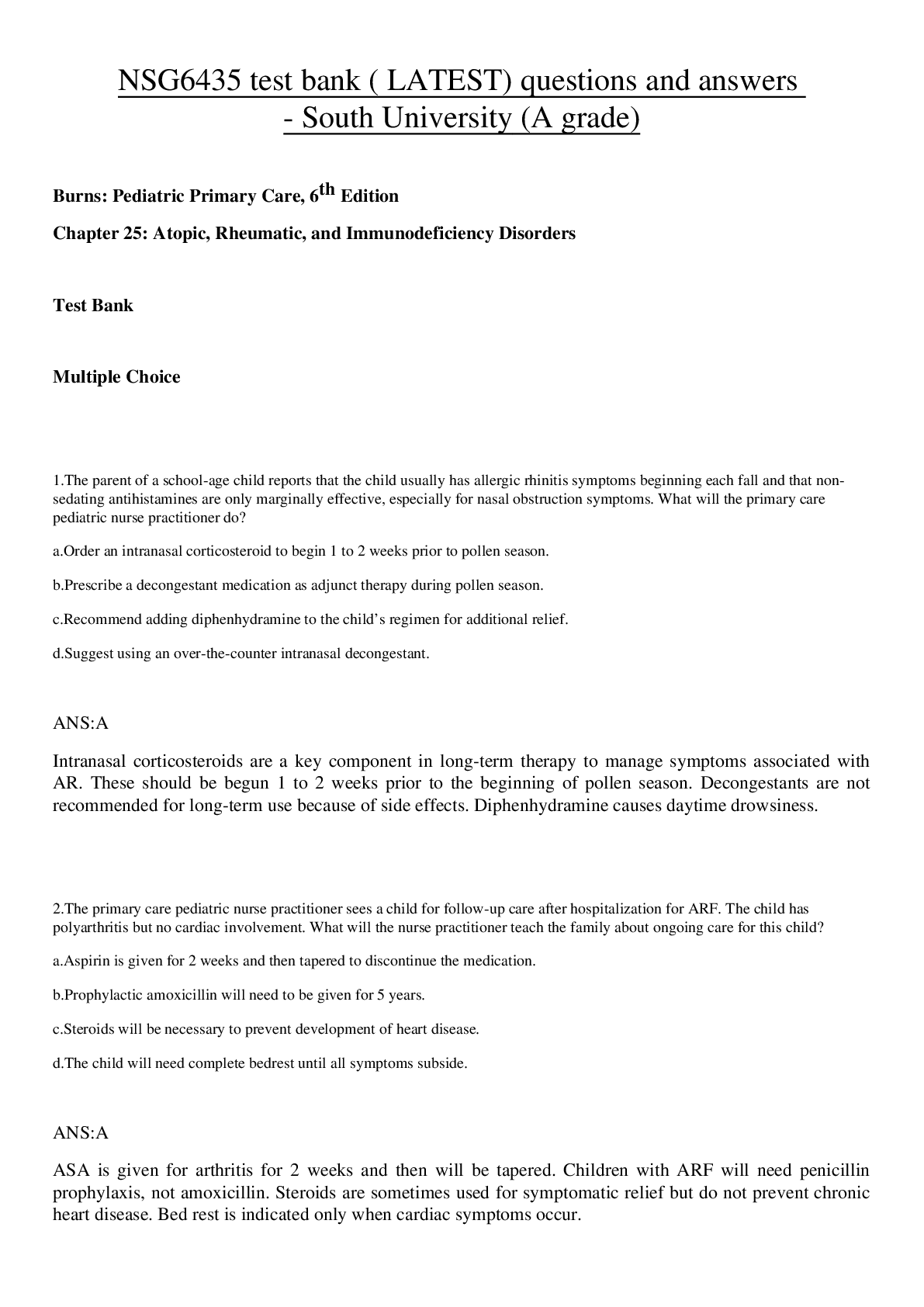
Reviews( 0 )
Document information
Connected school, study & course
About the document
Uploaded On
May 15, 2020
Number of pages
78
Written in
Additional information
This document has been written for:
Uploaded
May 15, 2020
Downloads
0
Views
88

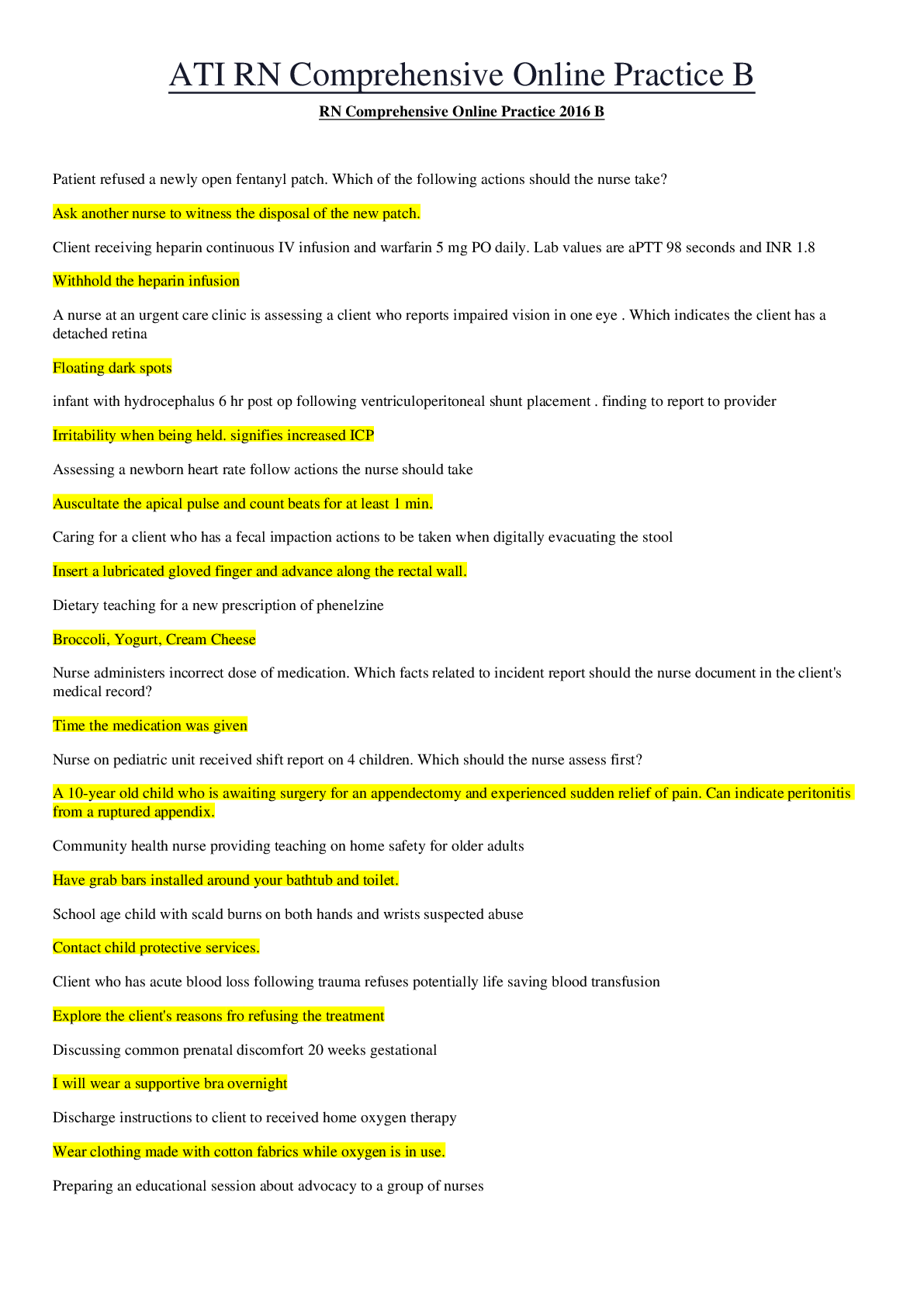
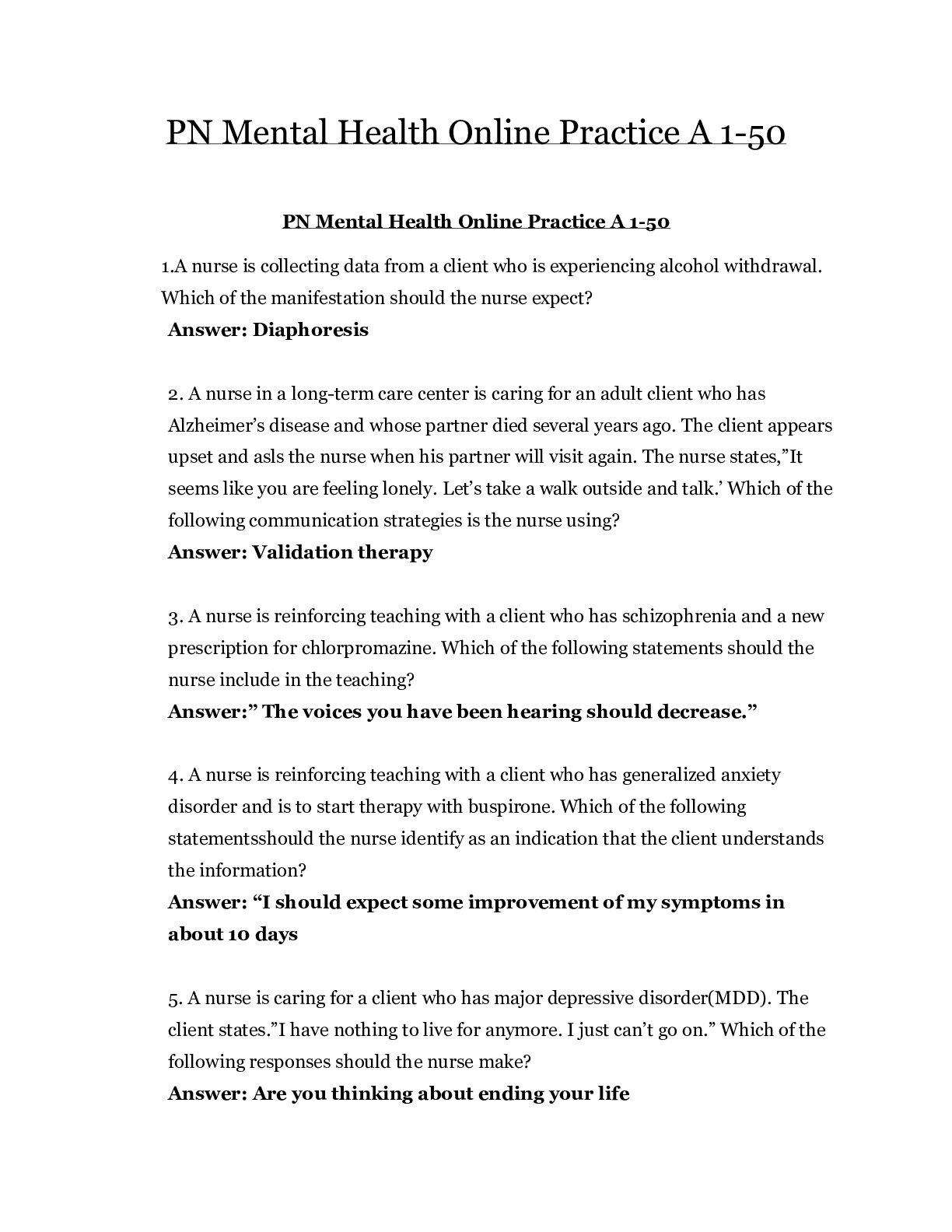
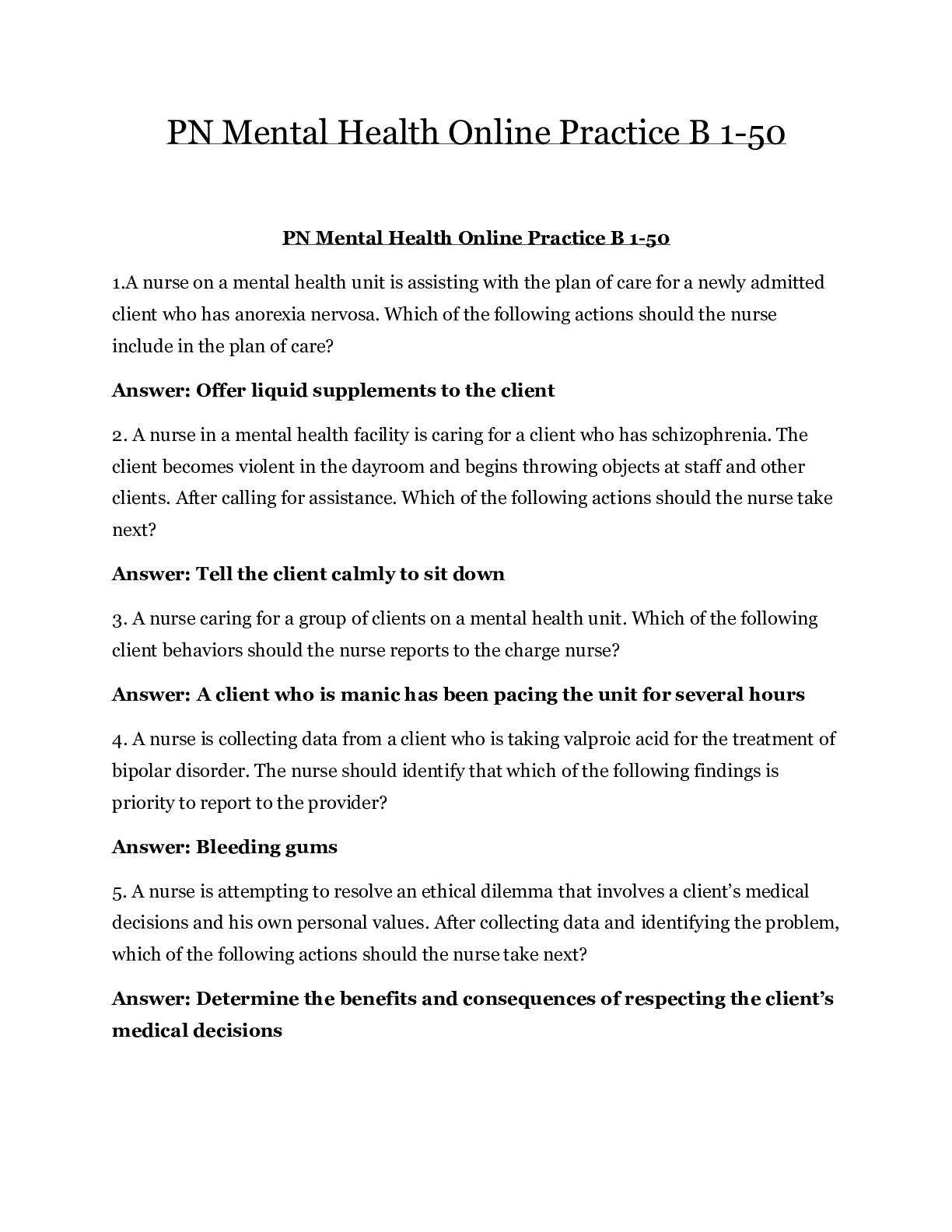
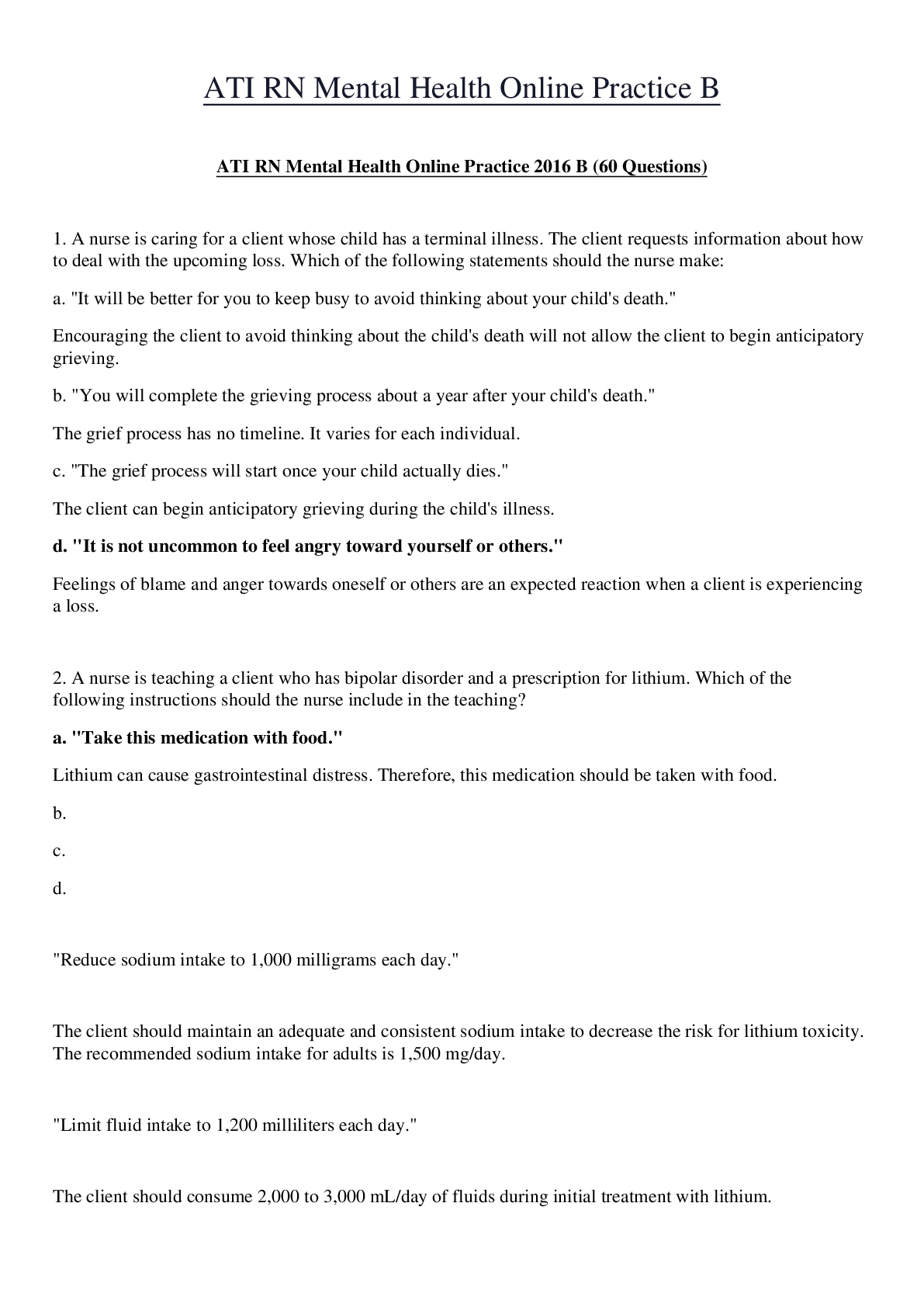


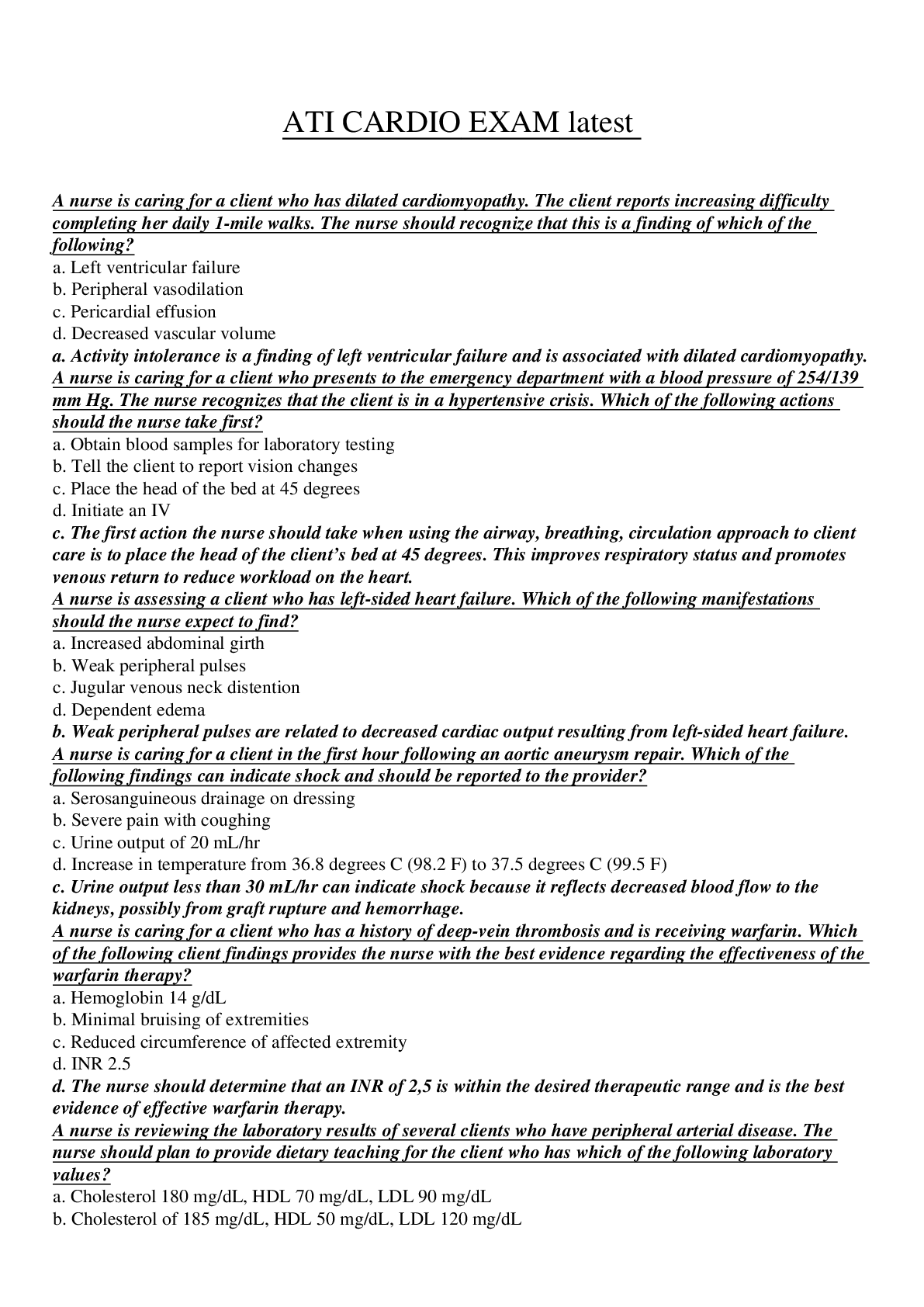
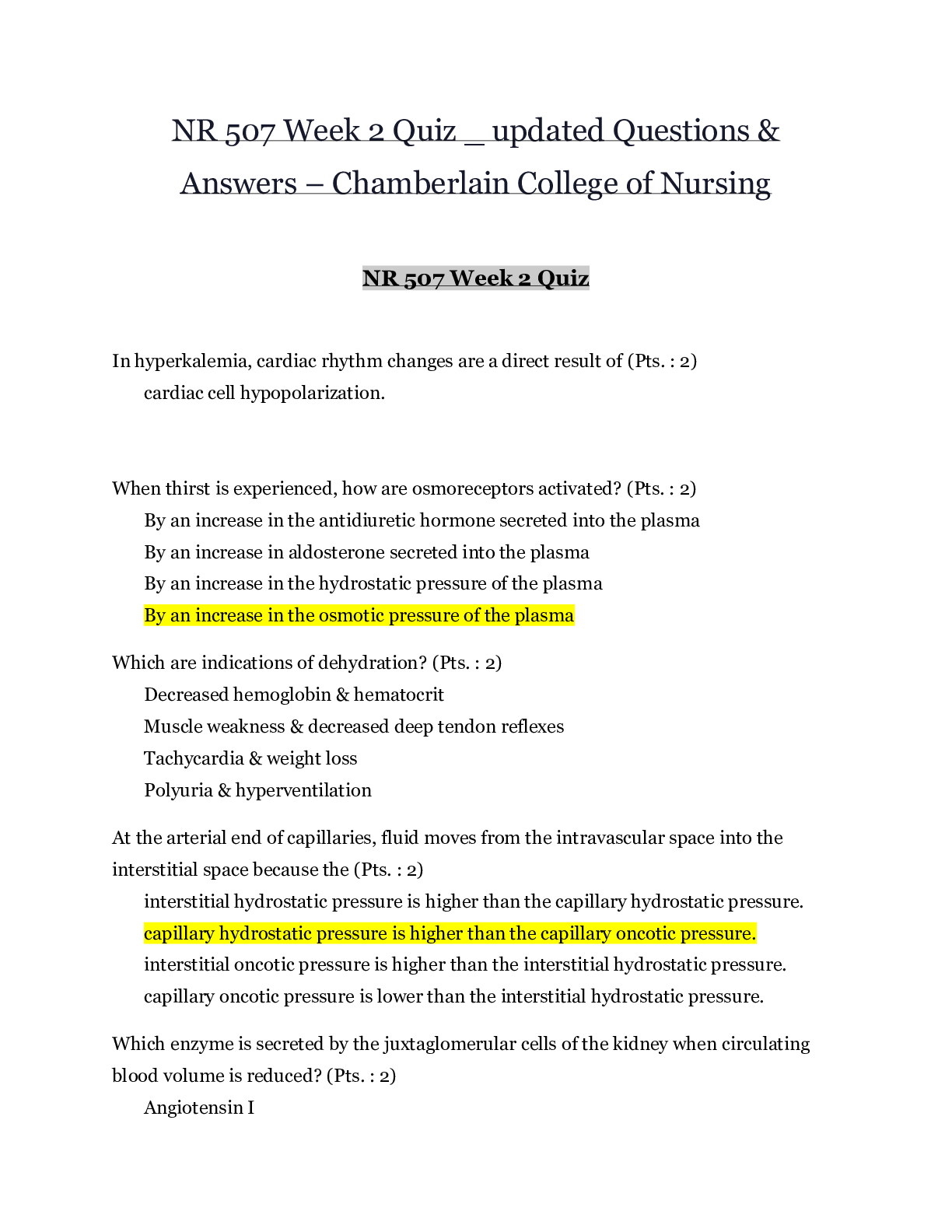
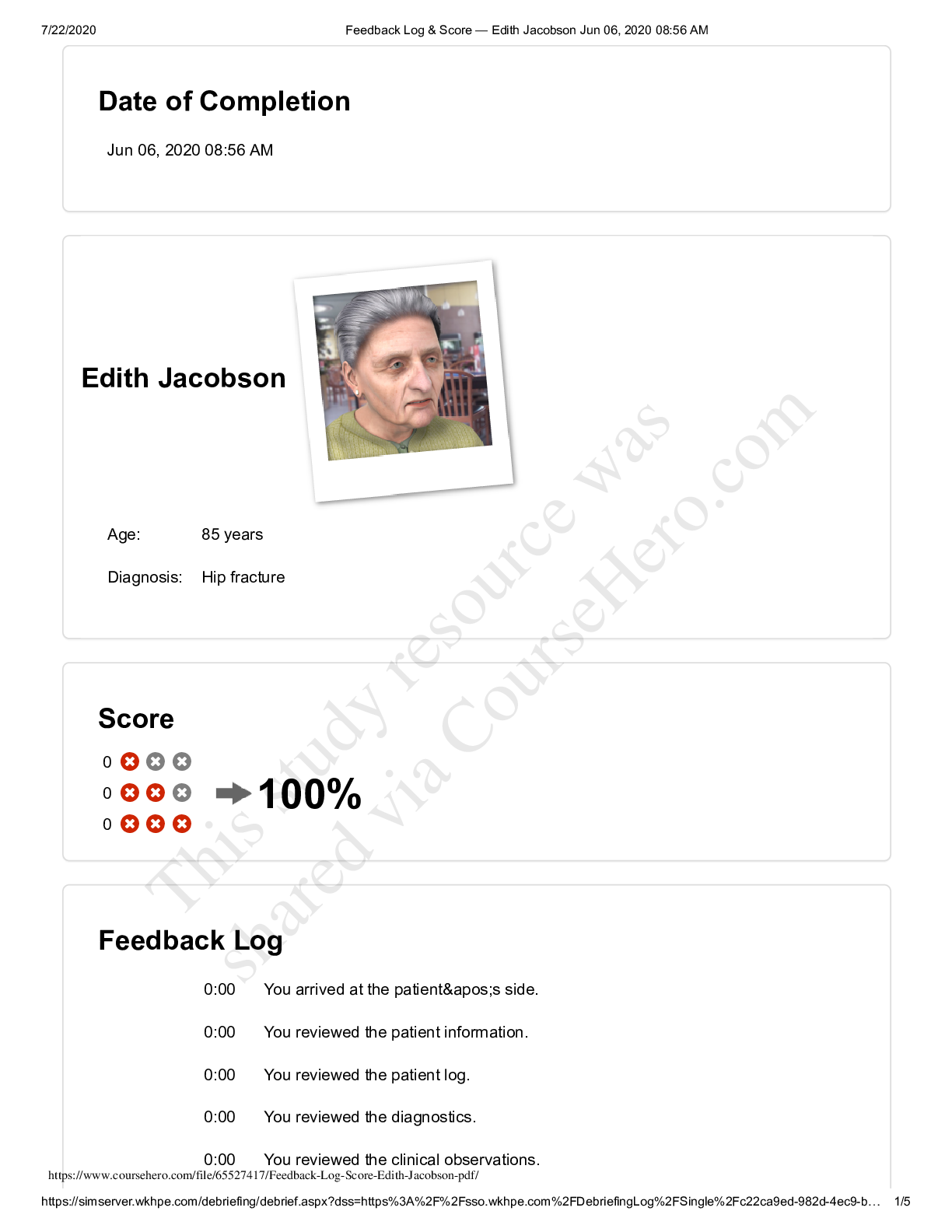
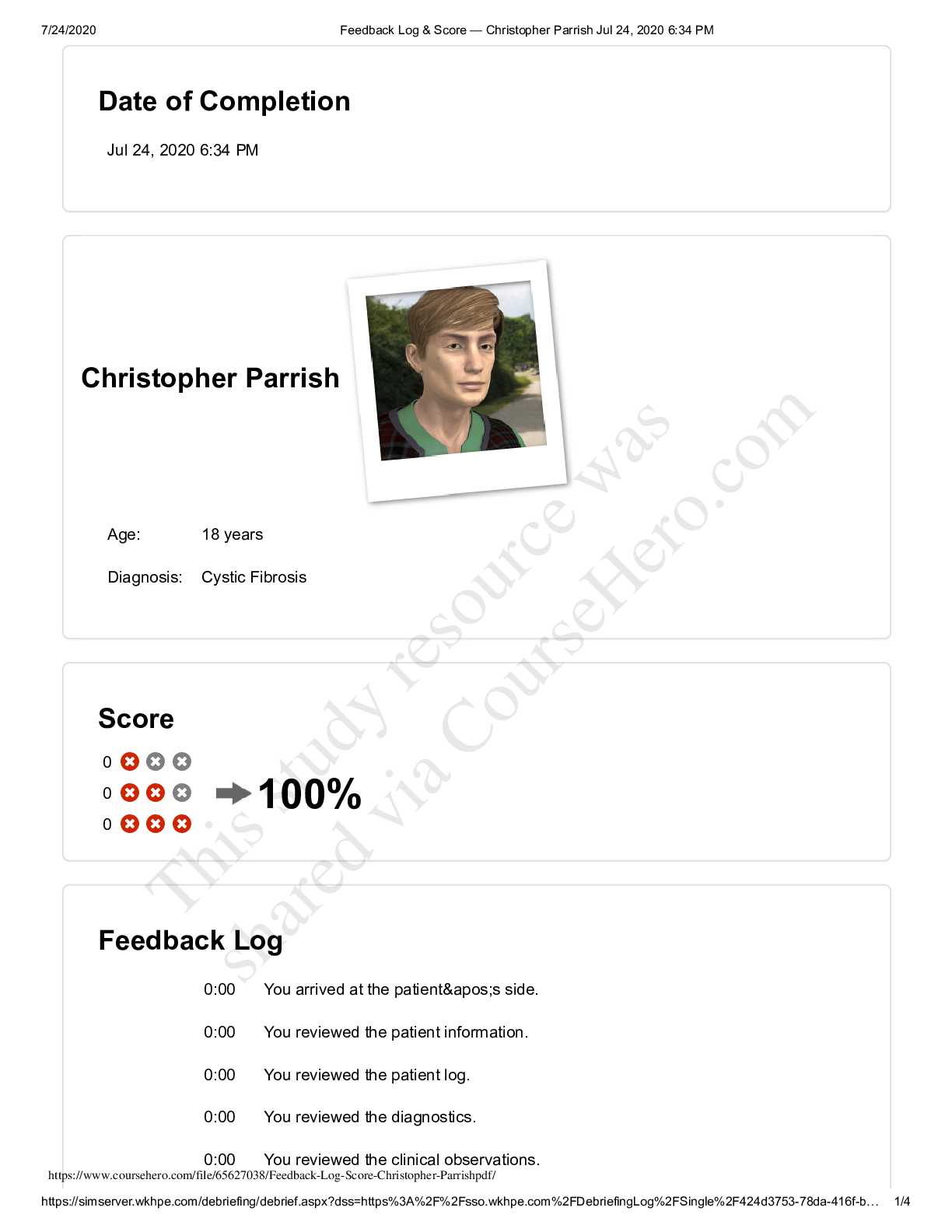
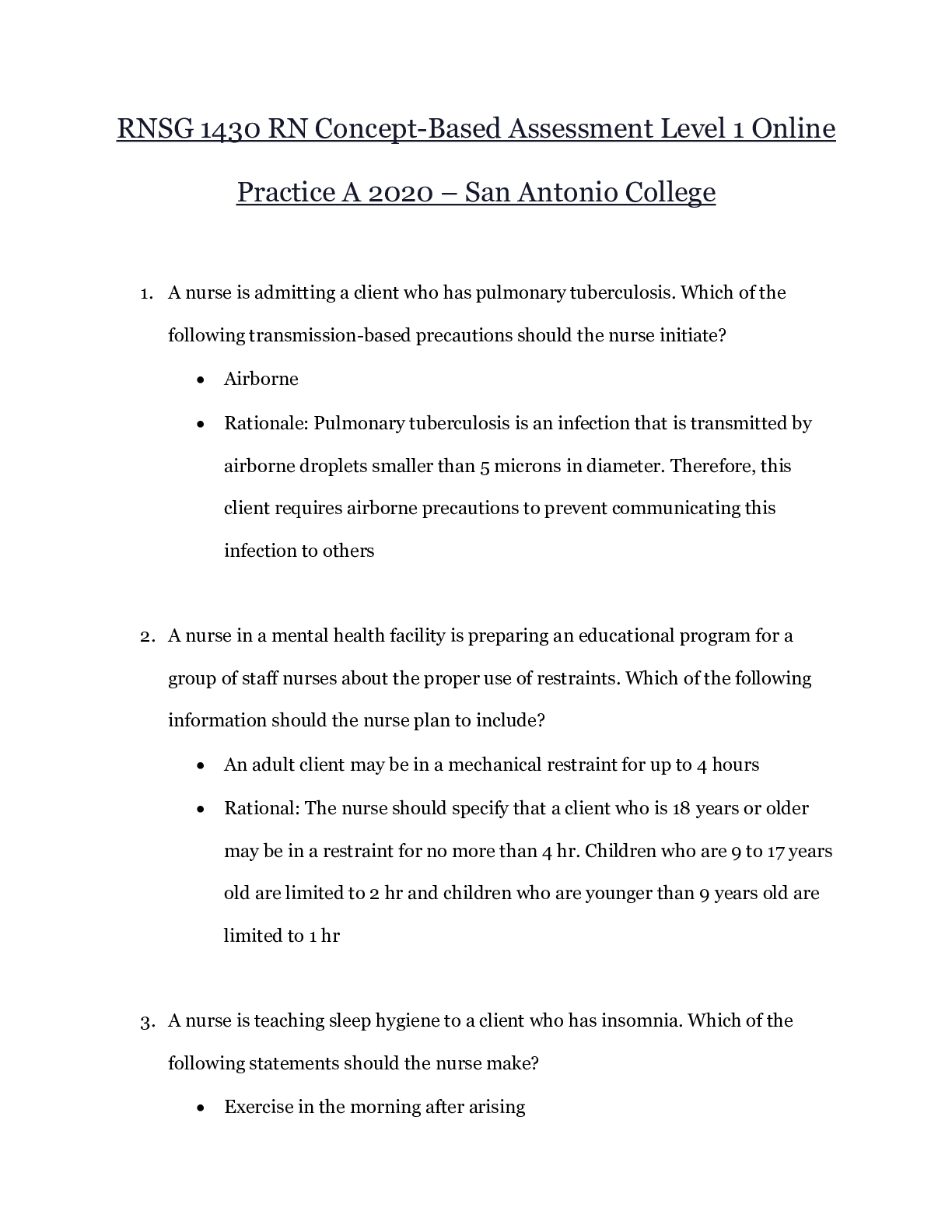


 – CHAMBERLAIN COLLEGE OF NURSING.png)
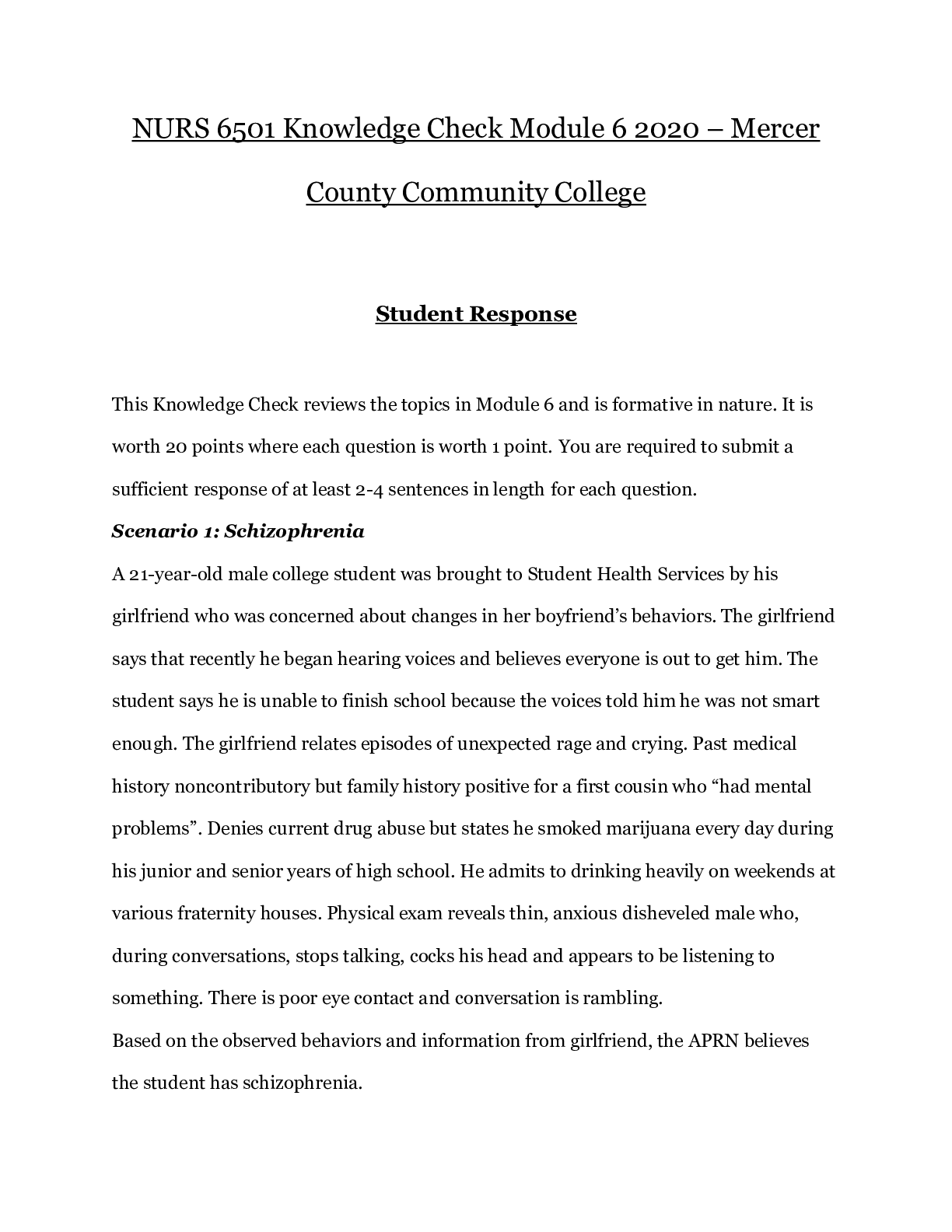
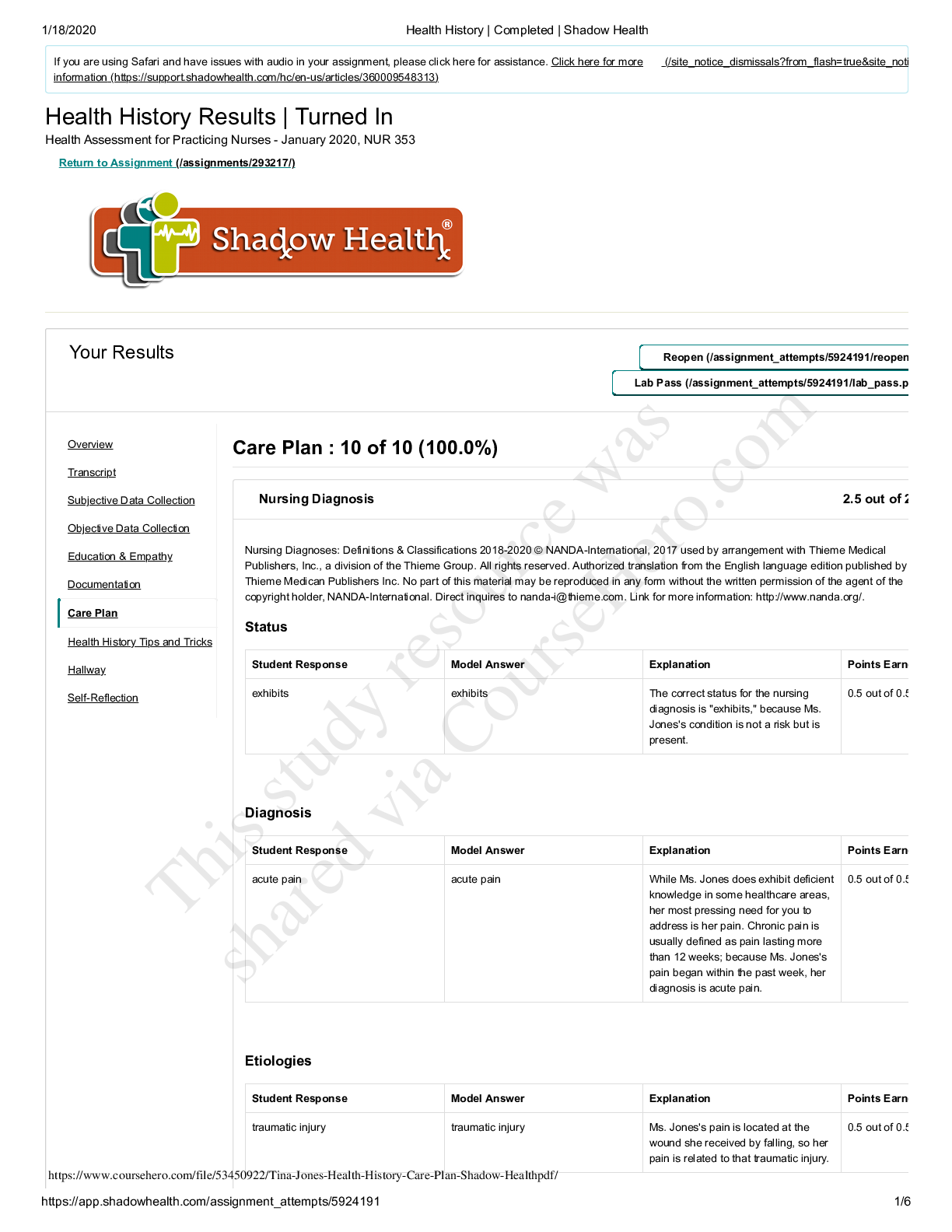

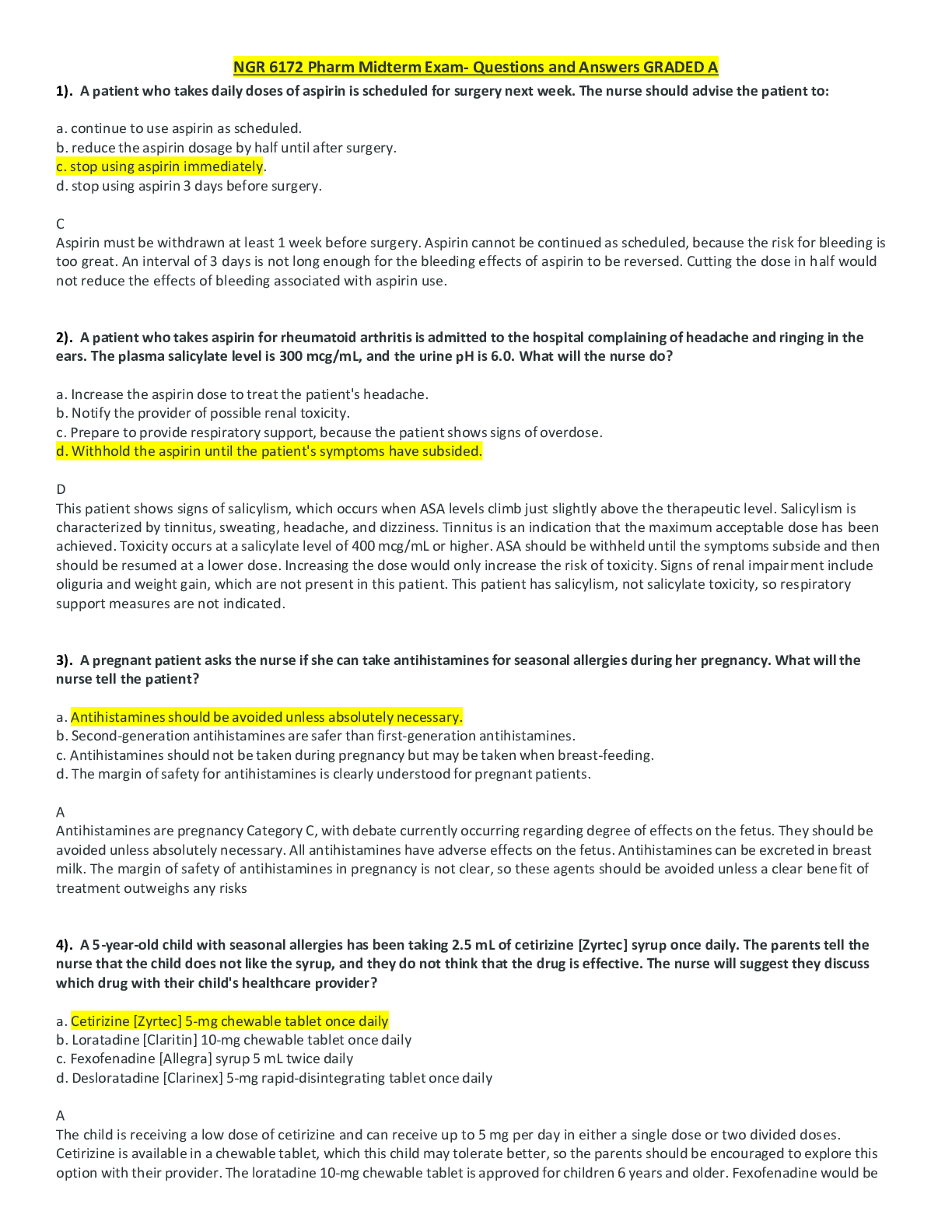

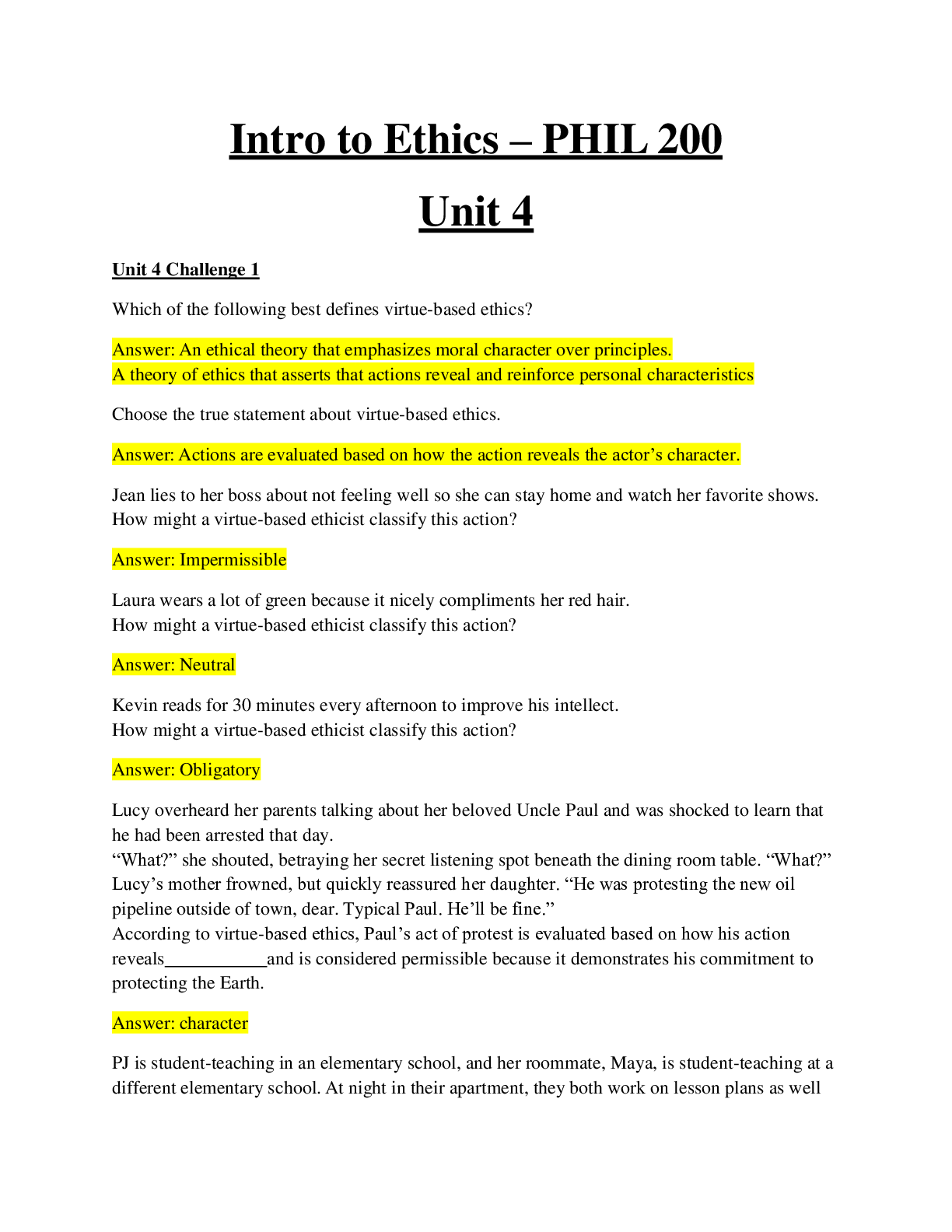
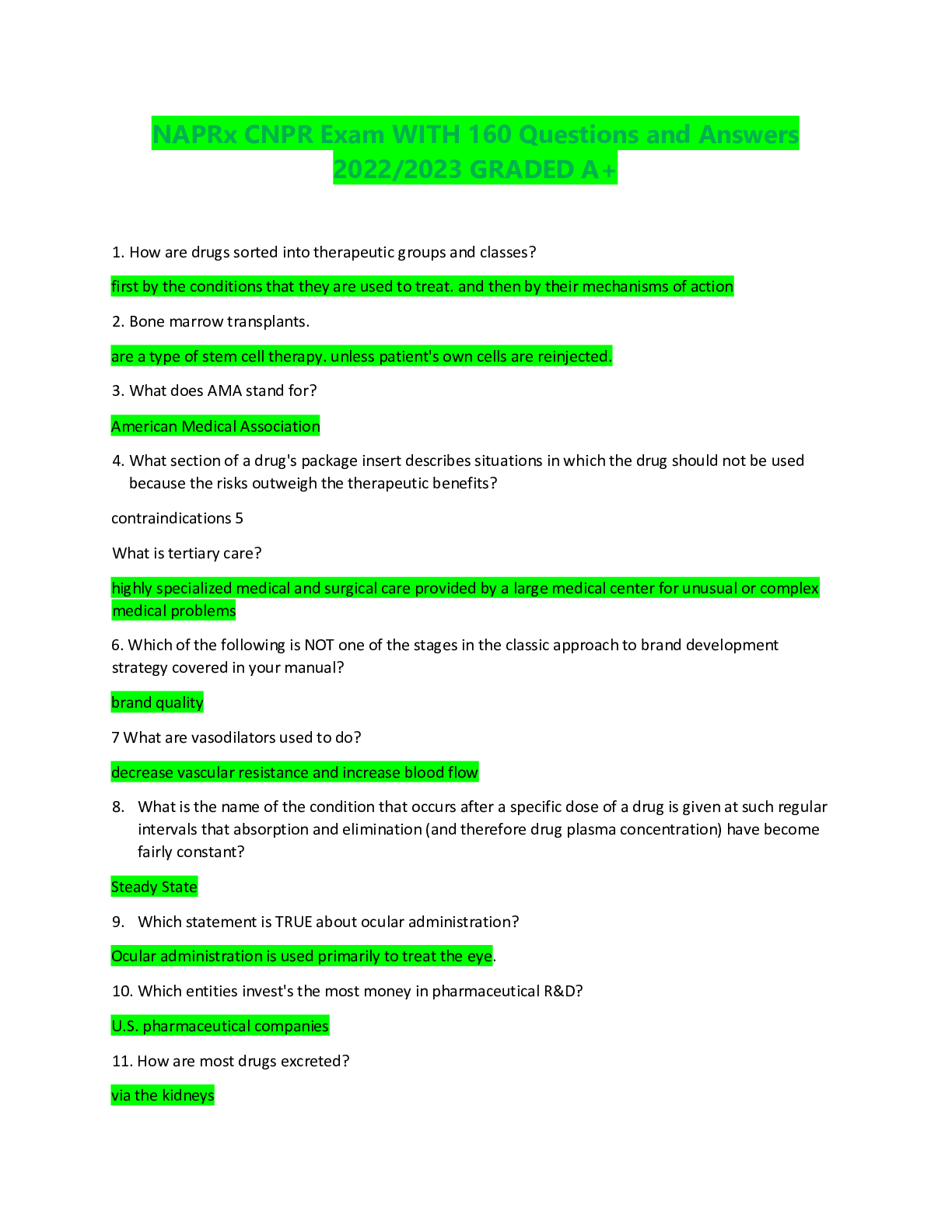
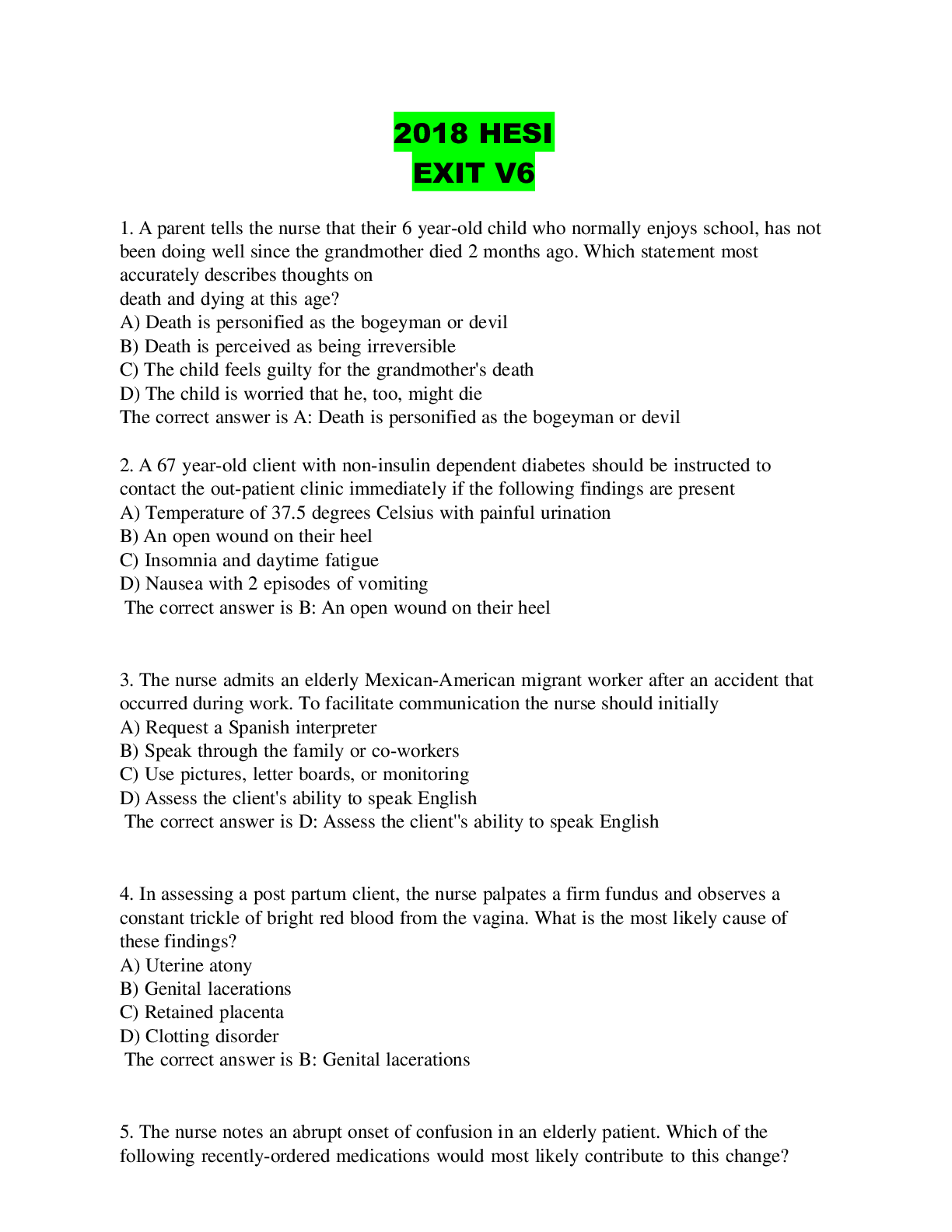
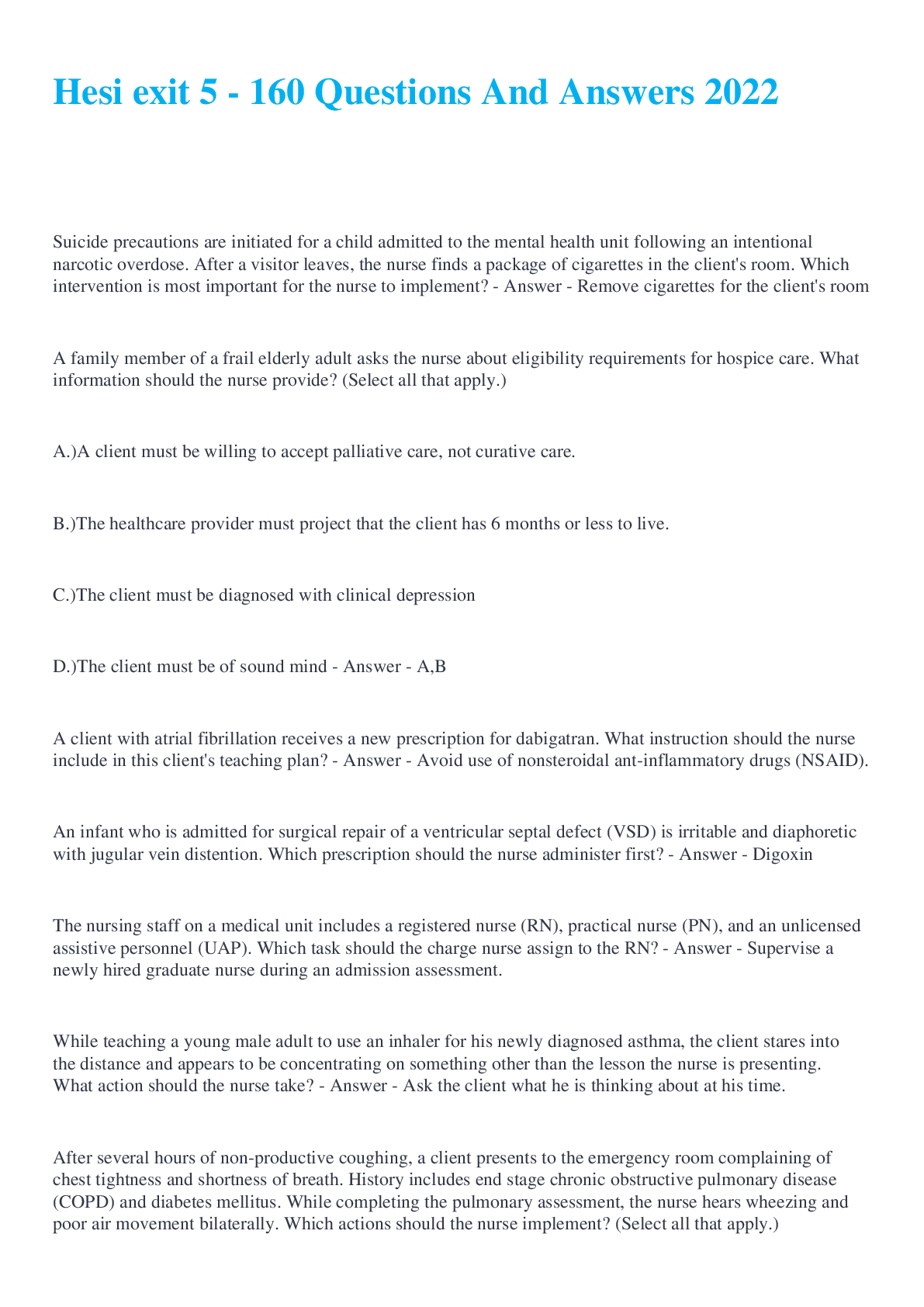
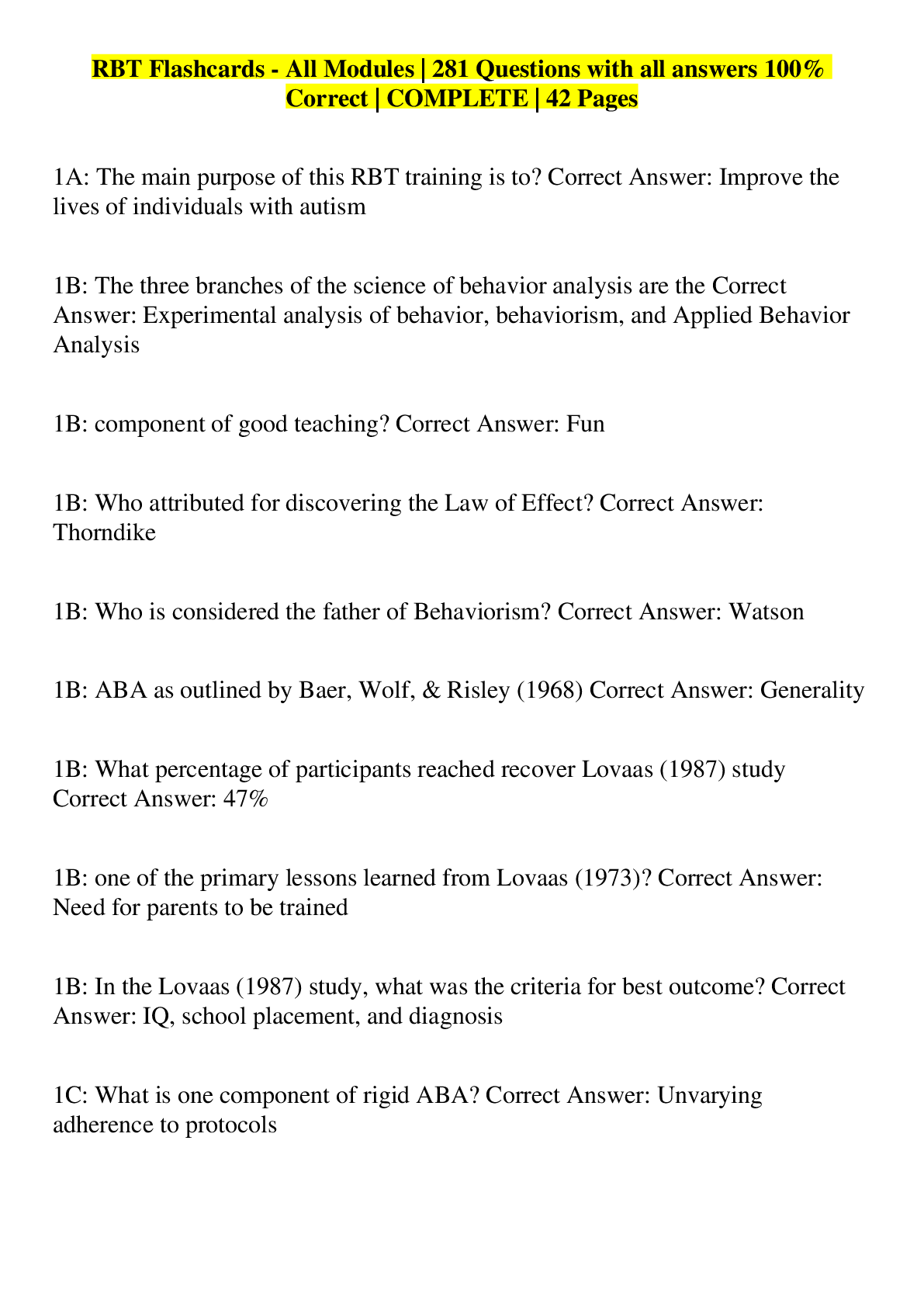
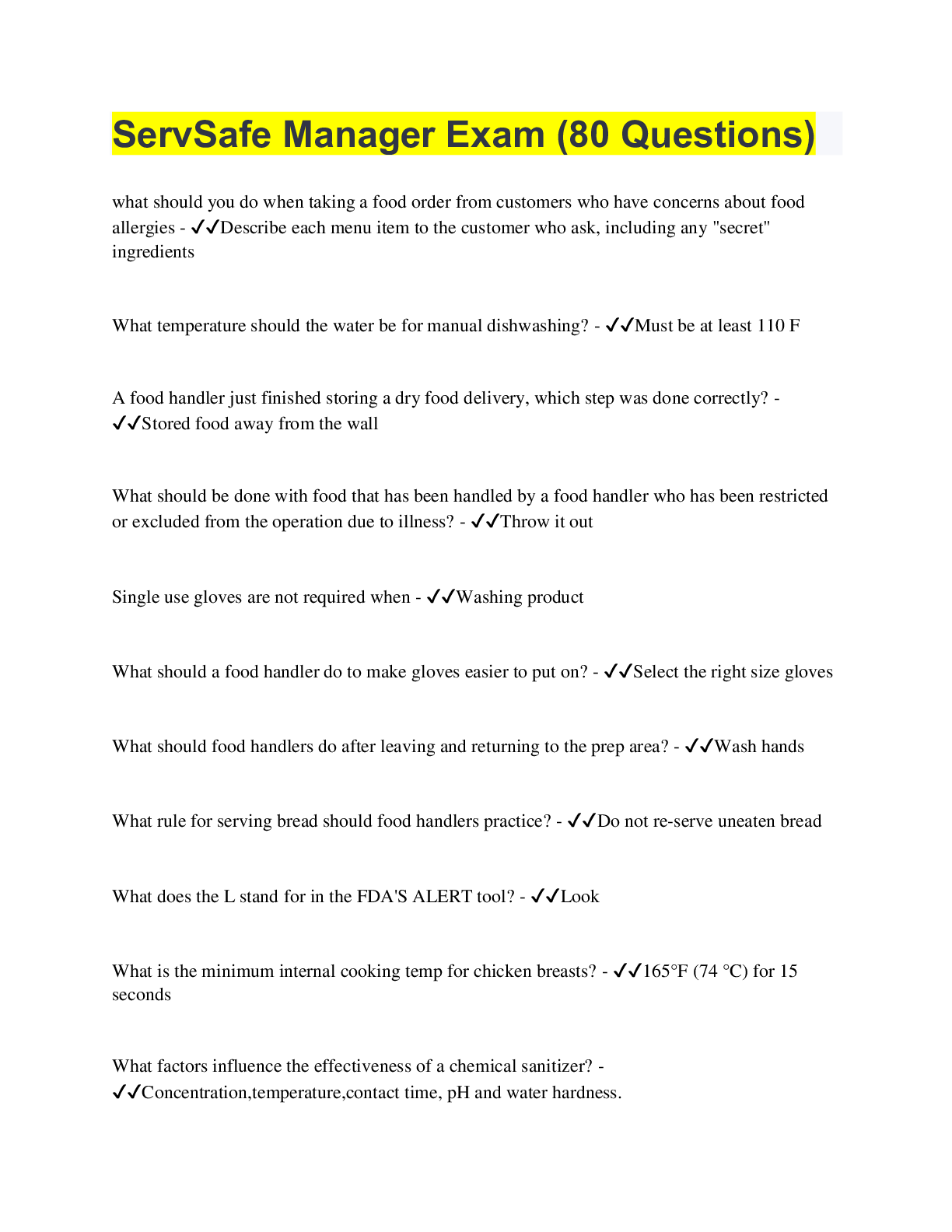
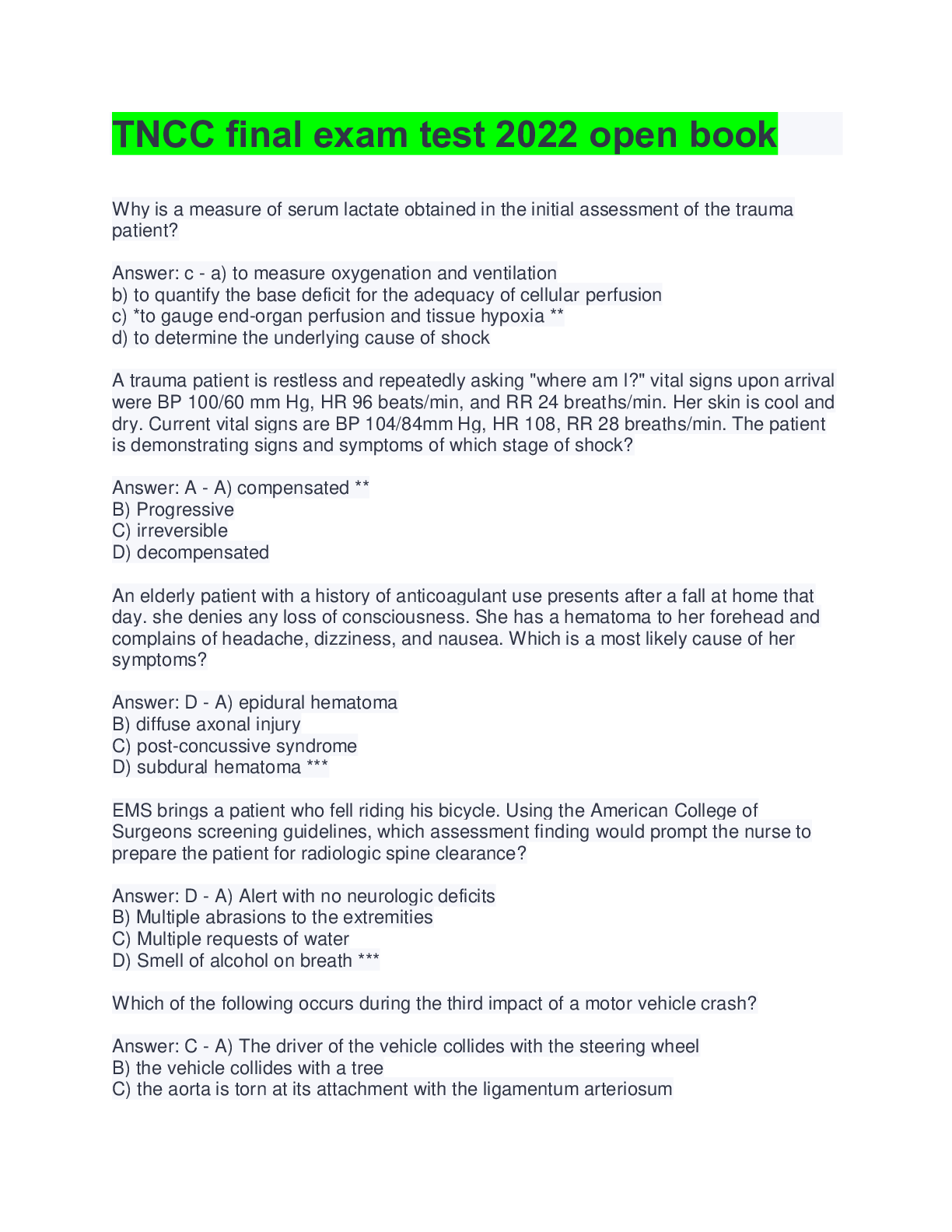

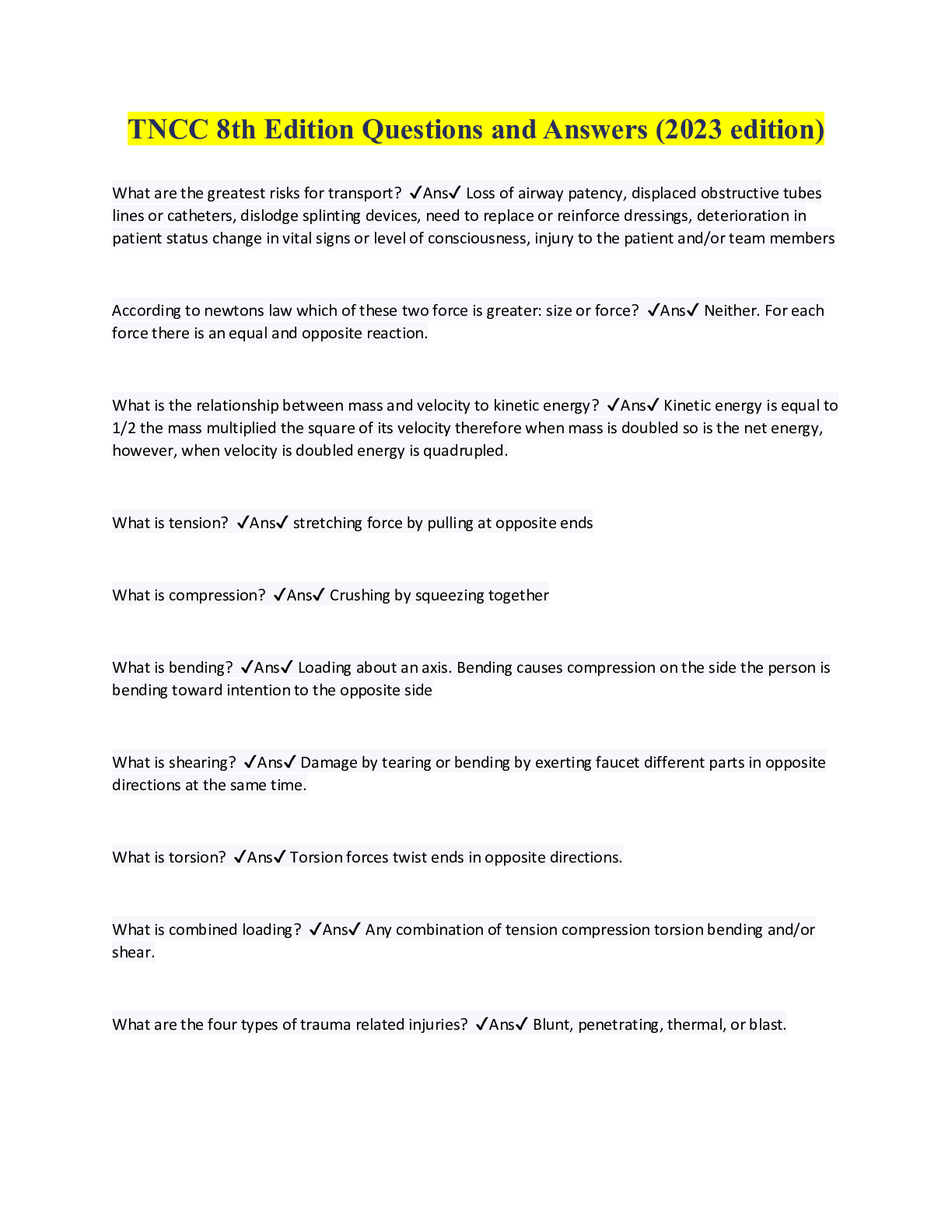

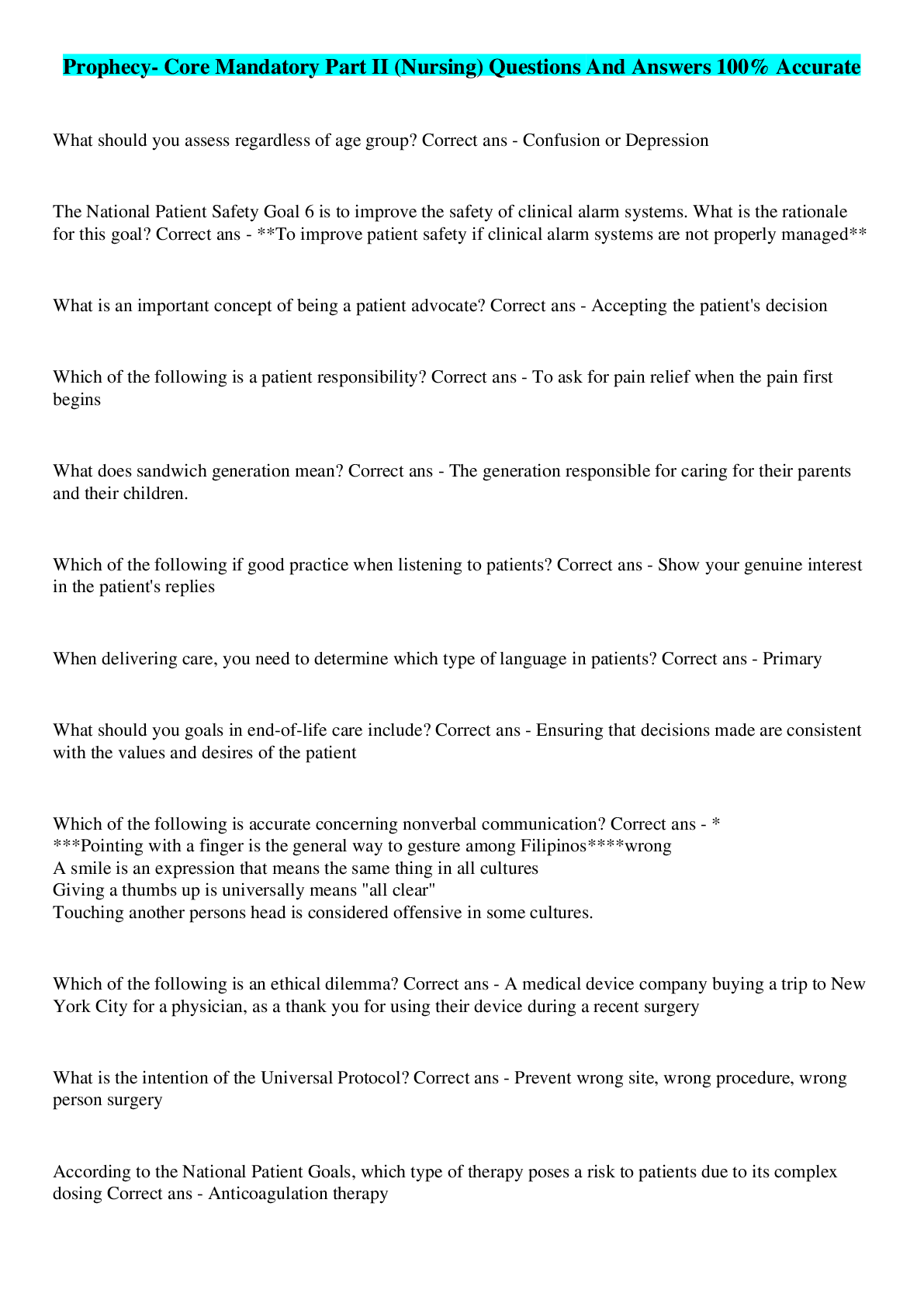
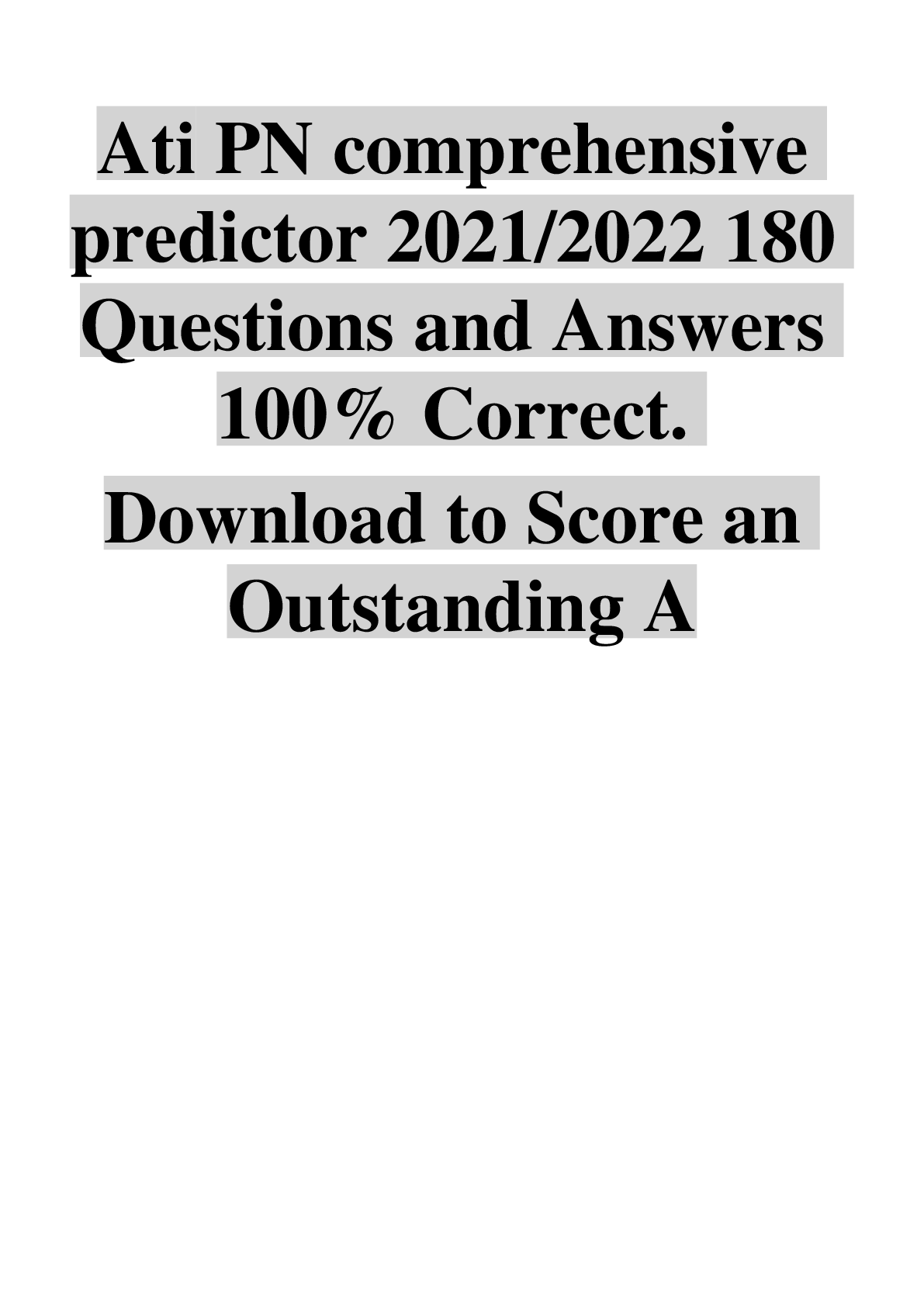
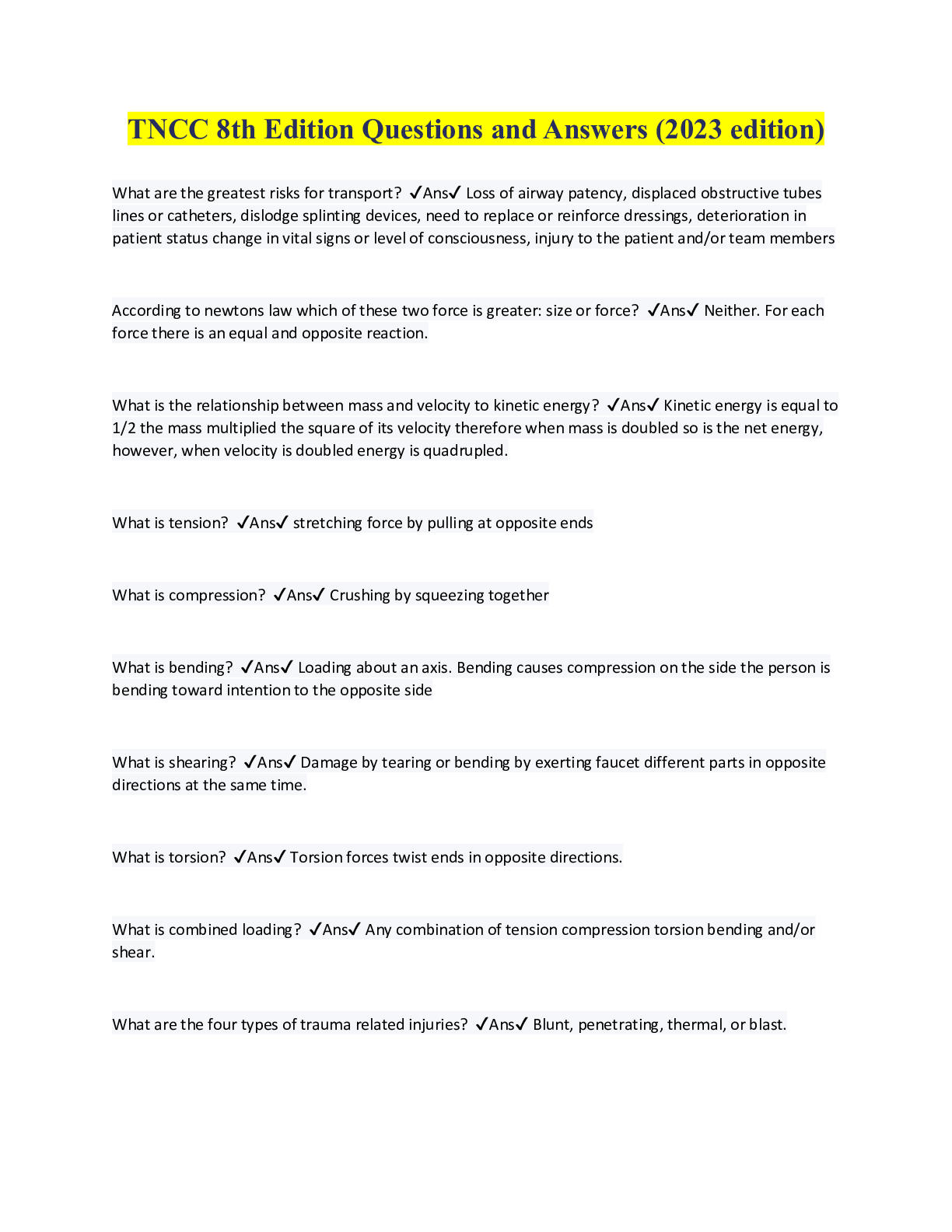
.png)
